Frida Kahlo
Painter Frida Kahlo was a Mexican artist who was married to Diego Rivera and is still admired as a feminist icon.
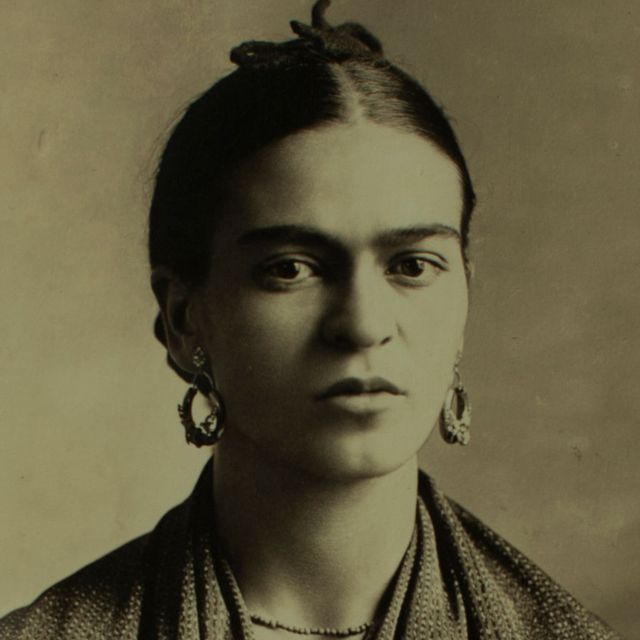
(1907-1954)

Who Was Frida Kahlo?
Artist Frida Kahlo was considered one of Mexico's greatest artists who began painting mostly self-portraits after she was severely injured in a bus accident. Kahlo later became politically active and married fellow communist artist Diego Rivera in 1929. She exhibited her paintings in Paris and Mexico before her death in 1954.
Family, Education and Early Life
Kahlo was born Magdalena Carmen Frieda Kahlo y Calderón on July 6, 1907, in Coyoacán, Mexico City, Mexico.
Kahlo's father, Wilhelm (also called Guillermo), was a German photographer who had immigrated to Mexico where he met and married her mother Matilde. She had two older sisters, Matilde and Adriana, and her younger sister, Cristina, was born the year after Kahlo.
Around the age of six, Kahlo contracted polio, which caused her to be bedridden for nine months. While she recovered from the illness, she limped when she walked because the disease had damaged her right leg and foot. Her father encouraged her to play soccer, go swimming, and even wrestle — highly unusual moves for a girl at the time — to help aid in her recovery.
In 1922, Kahlo enrolled at the renowned National Preparatory School. She was one of the few female students to attend the school, and she became known for her jovial spirit and her love of colorful, traditional clothes and jewelry.
While at school, Kahlo hung out with a group of politically and intellectually like-minded students. Becoming more politically active, Kahlo joined the Young Communist League and the Mexican Communist Party.
Frida Kahlo's Accident
After staying at the Red Cross Hospital in Mexico City for several weeks, Kahlo returned home to recuperate further. She began painting during her recovery and finished her first self-portrait the following year, which she gave to Gómez Arias.
Frida Kahlo's Marriage to Diego Rivera
In 1929, Kahlo and famed Mexican muralist Diego Rivera married. Kahlo and Rivera first met in 1922 when he went to work on a project at her high school. Kahlo often watched as Rivera created a mural called The Creation in the school’s lecture hall. According to some reports, she told a friend that she would someday have Rivera’s baby.
Kahlo reconnected with Rivera in 1928. He encouraged her artwork, and the two began a relationship. During their early years together, Kahlo often followed Rivera based on where the commissions that Rivera received were. In 1930, they lived in San Francisco, California. They then went to New York City for Rivera’s show at the Museum of Modern Art and later moved to Detroit for Rivera’s commission with the Detroit Institute of Arts.
Kahlo and Rivera’s time in New York City in 1933 was surrounded by controversy. Commissioned by Nelson Rockefeller , Rivera created a mural entitled Man at the Crossroads in the RCA Building at Rockefeller Center. Rockefeller halted the work on the project after Rivera included a portrait of communist leader Vladimir Lenin in the mural, which was later painted over. Months after this incident, the couple returned to Mexico and went to live in San Angel, Mexico.
Never a traditional union, Kahlo and Rivera kept separate, but adjoining homes and studios in San Angel. She was saddened by his many infidelities, including an affair with her sister Cristina. In response to this familial betrayal, Kahlo cut off most of her trademark long dark hair. Desperately wanting to have a child, she again experienced heartbreak when she miscarried in 1934.
Kahlo and Rivera went through periods of separation, but they joined together to help exiled Soviet communist Leon Trotsky and his wife Natalia in 1937. The Trotskys came to stay with them at the Blue House (Kahlo's childhood home) for a time in 1937 as Trotsky had received asylum in Mexico. Once a rival of Soviet leader Joseph Stalin , Trotsky feared that he would be assassinated by his old nemesis. Kahlo and Trotsky reportedly had a brief affair during this time.
Kahlo divorced Rivera in 1939. They did not stay divorced for long, remarrying in 1940. The couple continued to lead largely separate lives, both becoming involved with other people over the years .
Artistic Career
While she never considered herself a surrealist, Kahlo befriended one of the primary figures in that artistic and literary movement, Andre Breton, in 1938. That same year, she had a major exhibition at a New York City gallery, selling about half of the 25 paintings shown there. Kahlo also received two commissions, including one from famed magazine editor Clare Boothe Luce, as a result of the show.
In 1939, Kahlo went to live in Paris for a time. There she exhibited some of her paintings and developed friendships with such artists as Marcel Duchamp and Pablo Picasso .
Kahlo received a commission from the Mexican government for five portraits of important Mexican women in 1941, but she was unable to finish the project. She lost her beloved father that year and continued to suffer from chronic health problems. Despite her personal challenges, her work continued to grow in popularity and was included in numerous group shows around this time.
In 1953, Kahlo received her first solo exhibition in Mexico. While bedridden at the time, Kahlo did not miss out on the exhibition’s opening. Arriving by ambulance, Kahlo spent the evening talking and celebrating with the event’s attendees from the comfort of a four-poster bed set up in the gallery just for her.
After Kahlo’s death, the feminist movement of the 1970s led to renewed interest in her life and work, as Kahlo was viewed by many as an icon of female creativity.
Frida Kahlo's Most Famous Paintings
Many of Kahlo’s works were self-portraits. A few of her most notable paintings include:
'Frieda and Diego Rivera' (1931)
Kahlo showed this painting at the Sixth Annual Exhibition of the San Francisco Society of Women Artists, the city where she was living with Rivera at the time. In the work, painted two years after the couple married, Kahlo lightly holds Rivera’s hand as he grasps a palette and paintbrushes with the other — a stiffly formal pose hinting at the couple’s future tumultuous relationship. The work now lives at the San Francisco Museum of Modern Art.
'Henry Ford Hospital' (1932)
In 1932, Kahlo incorporated graphic and surrealistic elements in her work. In this painting, a naked Kahlo appears on a hospital bed with several items — a fetus, a snail, a flower, a pelvis and others — floating around her and connected to her by red, veinlike strings. As with her earlier self-portraits, the work was deeply personal, telling the story of her second miscarriage.
'The Suicide of Dorothy Hale' (1939)
Kahlo was asked to paint a portrait of Luce and Kahlo's mutual friend, actress Dorothy Hale, who had committed suicide earlier that year by jumping from a high-rise building. The painting was intended as a gift for Hale's grieving mother. Rather than a traditional portrait, however, Kahlo painted the story of Hale's tragic leap. While the work has been heralded by critics, its patron was horrified at the finished painting.
'The Two Fridas' (1939)
One of Kahlo’s most famous works, the painting shows two versions of the artist sitting side by side, with both of their hearts exposed. One Frida is dressed nearly all in white and has a damaged heart and spots of blood on her clothing. The other wears bold colored clothing and has an intact heart. These figures are believed to represent “unloved” and “loved” versions of Kahlo.
'The Broken Column' (1944)
Kahlo shared her physical challenges through her art again with this painting, which depicted a nearly nude Kahlo split down the middle, revealing her spine as a shattered decorative column. She also wears a surgical brace and her skin is studded with tacks or nails. Around this time, Kahlo had several surgeries and wore special corsets to try to fix her back. She would continue to seek a variety of treatments for her chronic physical pain with little success.
DOWNLOAD BIOGRAPHY'S FRIDA KAHLO FACT CARD
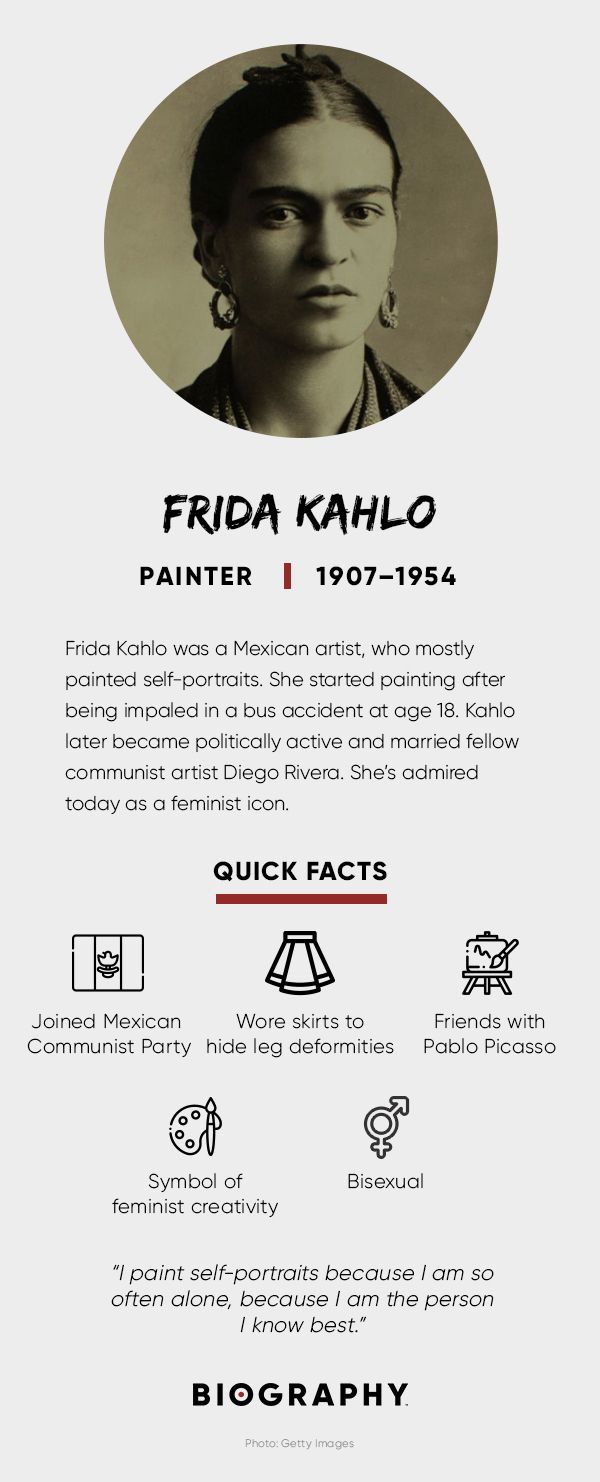
Frida Kahlo’s Death
About a week after her 47th birthday, Kahlo died on July 13, 1954, at her beloved Blue House. There has been some speculation regarding the nature of her death. It was reported to be caused by a pulmonary embolism, but there have also been stories about a possible suicide.
Kahlo’s health issues became nearly all-consuming in 1950. After being diagnosed with gangrene in her right foot, Kahlo spent nine months in the hospital and had several operations during this time. She continued to paint and support political causes despite having limited mobility. In 1953, part of Kahlo’s right leg was amputated to stop the spread of gangrene.
Deeply depressed, Kahlo was hospitalized again in April 1954 because of poor health, or, as some reports indicated, a suicide attempt. She returned to the hospital two months later with bronchial pneumonia. No matter her physical condition, Kahlo did not let that stand in the way of her political activism. Her final public appearance was a demonstration against the U.S.-backed overthrow of President Jacobo Arbenz of Guatemala on July 2nd.
Movie on Frida Kahlo
Kahlo’s life was the subject of a 2002 film entitled Frida , starring Salma Hayek as the artist and Alfred Molina as Rivera. Directed by Julie Taymor, the film was nominated for six Academy Awards and won for Best Makeup and Original Score.
Frida Kahlo Museum
The family home where Kahlo was born and grew up, later referred to as the Blue House or Casa Azul, was opened as a museum in 1958. Located in Coyoacán, Mexico City, the Museo Frida Kahlo houses artifacts from the artist along with important works including Viva la Vida (1954), Frida and Caesarean (1931) and Portrait of my father Wilhelm Kahlo (1952).
Book on Frida Kahlo
Hayden Herrera’s 1983 book on Kahlo, Frida: A Biography of Frida Kahlo , helped to stir up interest in the artist. The biographical work covers Kahlo’s childhood, accident, artistic career, marriage to Diego Rivera, association with the communist party and love affairs.
QUICK FACTS
- Name: Frida Kahlo
- Birth Year: 1907
- Birth date: July 6, 1907
- Birth City: Mexico City
- Birth Country: Mexico
- Gender: Female
- Best Known For: Painter Frida Kahlo was a Mexican artist who was married to Diego Rivera and is still admired as a feminist icon.
- Astrological Sign: Cancer
- National Preparatory School
- Nacionalities
- Interesting Facts
- Frida Kahlo met Diego Rivera when he was commissioned to paint a mural at her high school.
- Kahlo dealt with chronic pain most of her life due to a bus accident.
- Death Year: 1954
- Death date: July 13, 1954
- Death City: Mexico City
- Death Country: Mexico
We strive for accuracy and fairness.If you see something that doesn't look right, contact us !
CITATION INFORMATION
- Article Title: Frida Kahlo Biography
- Author: Biography.com Editors
- Website Name: The Biography.com website
- Url: https://www.biography.com/artists/frida-kahlo
- Access Date:
- Publisher: A&E; Television Networks
- Last Updated: November 19, 2021
- Original Published Date: April 2, 2014
- I never paint dreams or nightmares. I paint my own reality.
- My painting carries with it the message of pain.
- I paint self-portraits because I am so often alone, because I am the person I know best.
- I think that, little by little, I'll be able to solve my problems and survive.
- The only thing I know is that I paint because I need to, and I paint whatever passes through my head without any other consideration.
- I was born a bitch. I was born a painter.
- I love you more than my own skin.
- I am not sick, I am broken, but I am happy as long as I can paint.
- Feet, what do I need you for when I have wings to fly?
- I tried to drown my sorrows, but the bastards learned how to swim, and now I am overwhelmed with this decent and good feeling.
- There have been two great accidents in my life. One was the trolley and the other was Diego. Diego was by far the worst.
- I hope the end is joyful, and I hope never to return.
The Biography.com staff is a team of people-obsessed and news-hungry editors with decades of collective experience. We have worked as daily newspaper reporters, major national magazine editors, and as editors-in-chief of regional media publications. Among our ranks are book authors and award-winning journalists. Our staff also works with freelance writers, researchers, and other contributors to produce the smart, compelling profiles and articles you see on our site. To meet the team, visit our About Us page: https://www.biography.com/about/a43602329/about-us
Famous Painters

11 Notable Artists from the Harlem Renaissance

Fernando Botero

Gustav Klimt

The Surreal Romance of Salvador and Gala Dalí

Salvador Dalí

Margaret Keane

Andy Warhol
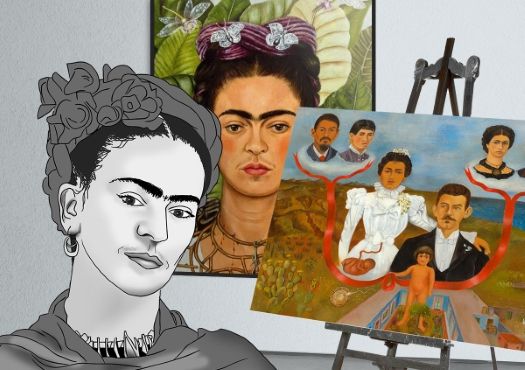
Frida Kahlo
Mexican Painter

Summary of Frida Kahlo
Small pins pierce Kahlo's skin to reveal that she still 'hurts' following illness and accident, whilst a signature tear signifies her ongoing battle with the related psychological overflow. Frida Kahlo typically uses the visual symbolism of physical pain in a long-standing attempt to better understand emotional suffering. Prior to Kahlo's efforts, the language of loss, death, and selfhood, had been relatively well investigated by some male artists (including Albrecht Dürer , Francisco Goya , and Edvard Munch ), but had not yet been significantly dissected by a woman. Indeed not only did Kahlo enter into an existing language, but she also expanded it and made it her own. By literally exposing interior organs, and depicting her own body in a bleeding and broken state, Kahlo opened up our insides to help explain human behaviors on the outside. She gathered together motifs that would repeat throughout her career, including ribbons, hair, and personal animals, and in turn created a new and articulate means to discuss the most complex aspects of female identity. As not only a 'great artist' but also a figure worthy of our devotion, Kahlo's iconic face provides everlasting trauma support and she has influence that cannot be underestimated.
Accomplishments
- Kahlo made it legitimate for women to outwardly display their pains and frustrations and to thus make steps towards understanding them. It became crucial for women artists to have a female role model and this is the gift of Frida Kahlo.
- As an important question for many Surrealists , Kahlo too considers: What is Woman? Following repeated miscarriages, she asks: to what extent does motherhood or its absence impact on female identity? She irreversibly alters the meaning of maternal subjectivity. It becomes clear through umbilical symbolism (often shown by ribbons) that Kahlo is connected to all that surrounds her, and that she is a 'mother' without children.
- Finding herself often alone, she worked obsessively with self-portraiture. Her reflection fueled an unflinching interest in identity. She was particularly interested in her mixed German-Mexican ancestry, as well as in her divided roles as artist, lover, and wife.
- Kahlo uses religious symbolism throughout her oeuvre . She appears as the Madonna holding her 'animal babies', and becomes the Virgin Mary as she cradles her husband and famous national painter Diego Rivera . She identifies with Saint Sebastian, and even fittingly appears as the martyred Christ. She positions herself as a prophet when she takes to the head of the table in her Last Supper -style painting, and her depiction of the accident which left her impaled on a metal bar (and covered in gold dust when lying injured) recalls the crucifixion and suggests her own holiness.
- Women prior to Kahlo who had attempted to communicate the wildest and deepest of emotions were often labeled hysterical or condemned insane - while men were aligned with the 'melancholy' character type. By remaining artistically active under the weight of sadness, Kahlo revealed that women too can be melancholy rather than depressed, and that these terms should not be thought of as gendered.
The Life of Frida Kahlo
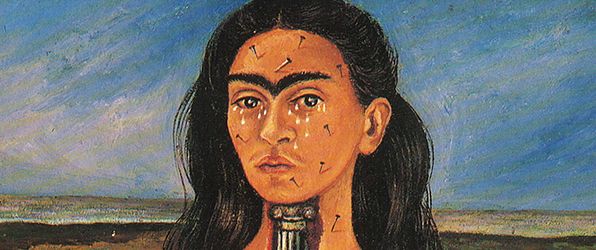
"I paint self-portraits because I am so often alone... because I am the subject I know best." From battles with her mind and her body, Kahlo lived through her art.
Important Art by Frida Kahlo

Frieda and Diego Rivera
It is as if in this painting Kahlo tries on the role of wife to see how it fits. She does not focus on her identity as a painter, but instead adopts a passive and supportive role, holding the hand of her talented and acclaimed husband. It was indeed the case that during the majority of her painting career, Kahlo was viewed only in Rivera's shadow and it was not until later in life that she gained international recognition. This early double-portrait was painted primarily to mark the celebration of Kahlo's marriage to Rivera. Whilst Rivera holds a palette and paint brushes, symbolic of his artistic mastery, Kahlo limits her role to his wife by presenting herself slight in frame and without her artistic accoutrements. Kahlo furthermore dresses in costume typical of the Mexican woman, or "La Mexicana," wearing a traditional red shawl known as the rebozo and jade Aztec beads. The positioning of the figures echoes that of traditional marital portraiture where the wife is placed on her husband's left to indicate her lesser moral status as a woman. In a drawing made the following year called Frida and the Miscarriage , the artist does hold her own palette, as though the experience of losing a fetus and not being able to create a baby shifts her determination wholly to the creation of art.
Oil on canvas - San Francisco Museum of Modern Art

Henry Ford Hospital
Many of Kahlo's paintings from the early 1930s, especially in size, format, architectural setting and spatial arrangement, relate to religious ex-voto paintings of which she and Rivera possessed a large collection ranging in date over several centuries. Ex-votos are made as a gesture of gratitude for salvation, a granted prayer or disaster averted and left in churches or at shrines. Ex-votos are generally painted on small-scale metal panels and depict the incident along with the Virgin or saint to whom they are offered. Henry Ford Hospital , is a good example where the artist uses the ex-voto format but subverts it by placing herself centre stage, rather than recording the miraculous deeds of saints. Kahlo instead paints her own story, as though she becomes saintly and the work is made not as thanks to the lord but in defiance, questioning why he brings her pain. In this painting, Kahlo lies on a bed, bleeding after a miscarriage. From the exposed naked body six vein-like ribbons flow outwards, attached to symbols. One of these six objects is a fetus, suggesting that the ribbons could be a metaphor for umbilical cords. The other five objects that surround Frida are things that she remembers, or things that she had seen in the hospital. For example, the snail makes reference to the time it took for the miscarriage to be over, whilst the flower was an actual physical object given to her by Diego. The artist demonstrates her need to be attached to all that surrounds her: to the mundane and metaphorical as much as the physical and actual. Perhaps it is through this reaching out of connectivity that the artist tries to be 'maternal', even though she is not able to have her own child.
Oil on canvas - Dolores Olmedo Collection, Mexico City, Mexico

This is a haunting painting in which both the birth giver and the birthed child seem dead. The head of the woman giving birth is shrouded in white cloth while the baby emerging from the womb appears lifeless. At the time that Kahlo painted this work, her mother had just died so it seems reasonable to assume that the shrouded funerary figure is her mother while the baby is Kahlo herself (the title supports this reading). However, Kahlo had also just lost her own child and has said that she is the covered mother figure. The Virgin of Sorrows , who hangs above the bed suggests that this is an image that overflows with maternal pain and suffering. Also though, and revealingly, Kahlo wrote in her diary, next to several small drawings of herself, 'the one who gave birth to herself ... who wrote the most wonderful poem of her life.' Similar to the drawing, Frida and the Miscarriage , My Birth represents Kahlo mourning for the loss of a child, but also finding the strength to make powerful art because of such trauma. The painting is made in a retablo (or votive) style (a small traditional Mexican painting derived from Catholic Church art) in which thanks would typically be given to the Madonna beneath the image. Kahlo instead leaves this section blank, as though she finds herself unable to give thanks either for her own birth, or for the fact that she is now unable to give birth. The painting seems to bring the message that it is important to acknowledge that birth and death live very closely together. Many believe that My Birth was heavily inspired by an Aztec sculpture that Kahlo had at home representing Tiazolteotl, the Goddess of fertility and midwives.
Oil and tempera on zinc - Private Collection

My Grandparents, My Parents, and I (Family Tree)
This dream-like family tree was painted on zinc rather than canvas, a choice that further highlights the artist's fascination with and collection of 18 th -century and 19 th -century Mexican retablos. Kahlo completed this work to accentuate both her European Jewish heritage and her Mexican background. Her paternal side, German Jewish, occupies the right side of the composition symbolized by the sea (acknowledging her father's voyage to get to Mexico), while her maternal side of Mexican descent is represented on the left by a map faintly outlining the topography of Mexico. While Kahlo's paintings are assertively autobiographical, she often used them to communicate transgressive or political messages: this painting was completed shortly after Adolf Hitler passed the Nuremberg laws banning interracial marriage. Here, Kahlo simultaneously affirms her mixed heritage to confront Nazi ideology, using a format - the genealogical chart - employed by the Nazi party to determine racial purity. Beyond politics, the red ribbon used to link the family members echoes the umbilical cord that connects baby Kahlo to her mother - a motif that recurs throughout Kahlo's oeuvre .
Oil and tempera on zinc - The Museum of Modern Art, New York

Fulang-Chang and I
This painting debuted at Kahlo's exhibition in Julien Levy's New York gallery in 1938, and was one of the works that most fascinated André Breton, the founder of Surrealism. The canvas in the New York show is a self-portrait of the artist and her spider monkey, Fulang-Chang, a symbol employed as a surrogate for the children that she and Rivera could not have. The arrangement of figures in the portrait signals the artist's interest in Renaissance paintings of the Madonna and child. After the New York exhibition, a second frame containing a mirror was added. The later inclusion of the mirror is a gesture inviting the viewer into the work: it was through looking at herself intensely in a mirror in her months spent at home after her bus accident that Kahlo first began painting portraits and delving deeper into her psyche. The inclusion of the mirror, considered from this perspective, is a remarkably intimate vision into both the artist's aesthetic process and into her personal introspection. In many of Kahlo's self-portraits, she is accompanied by monkeys, dogs, and parrots, all of which she kept as pets. Since the Middle Ages, small spider monkeys, like those kept by Kahlo, have been said to symbolize the devil, heresy, and paganism, finally coming to represent the fall of man, vice, and the embodiment of lust. These monkeys were depicted in the past as a cautionary symbol against the dangers of excessive love and the base instincts of man. Kahlo again depicts herself with her monkey in both 1939 and 1940. In a later version in 1945, Kahlo paints her monkey and also her dog, Xolotl. This little dog that often accompanies the artist, is named after a mythological Aztec god, known to represent lightning and death, and also to be the twin of Quetzalcoatl, both of who had visited the underworld. All of these pictures, including Fulang-Chang and I include 'umbilical' ribbons that wrap between Kahlo's and the animal's necks. Kahlo is the Madonna and her pets become the holy (yet darkly symbolic) infant for which she longs.
In two parts, oil on composition board (1937) with painted mirror frame (added after 1939) - The Museum of Modern Art, New York

What the Water Gave Me
In this painting most of Kahlo's body is obscured from view. We are unusually confronted with the foot and plug end of the bath, and with focus placed on the artist's feet. Furthermore, Kahlo adopts a birds-eye view and looks down on the water from above. Within the water, Kahlo paints an alternative self-portrait, one in which the more traditional facial portrait has been replaced by an array of symbols and recurring motifs. The artist includes portraits of her parents, a traditional Tehuana dress, a perforated shell, a dead humming bird, two female lovers, a skeleton, a crumbling skyscraper, a ship set sail, and a woman drowning. This painting was featured in Breton's 1938 book on Surrealism and Painting and Hayden Herrera, in her biography of Kahlo, mentions that the artist herself considered this work to have a special importance. Recalling the tapestry style painting of Northern Renaissance masters, Hieronymus Bosch and Pieter Bruegel the Elder, the figures and objects floating in the water of Kahlo's painting create an at once fantastic and real landscape of memory. Kahlo discussed What the Water Gave Me with the Manhattan gallery owner Julien Levy, and suggested that it was a sad piece that mourned the loss of her childhood. Perhaps the strangled figure at the centre is representative of the inner emotional torments experienced by Kahlo herself. It is clear from the conversation that the artist had with Levy, that Kahlo was aware of the philosophical implications of her work. In an interview with Herrera, Levy recalls, in 'a long philosophical discourse, Kahlo talked about the perspective of herself that is shown in this painting'. He further relays that 'her idea was about the image of yourself that you have because you do not see your head. The head is something that is looking, but is not seen. It is what one carries around to look at life with.' The artist's head in What the Water Gave Me is thus appropriately replaced by the interior thoughts that occupy her mind. As well as an inclusion of death by strangulation in the centre of the water, there is also a labia-like flower and a cluster of pubic hair painted between Kahlo's legs. The work is quite sexual while also showing preoccupation with destruction and death. The motif of the bathtub in art is one that has been popular since Jacques-Louis David's The Death of Marat (1793), and was later taken up many different personalities such as Francesca Woodman and Tracey Emin.
Oil on canvas - Private Collection

The Two Fridas
This double self-portrait is one of Kahlo's most recognized compositions, and is symbolic of the artist's emotional pain experienced during her divorce from Rivera. On the left, the artist is shown in modern European attire, wearing the costume from her marriage to Rivera. Throughout their marriage, given Rivera's strong nationalism, Kahlo became increasingly interested in indigenism and began to explore traditional Mexican costume, which she wears in the portrait on the right. It is the Mexican Kahlo that holds a locket with an image of Rivera. The stormy sky in the background, and the artist's bleeding heart - a fundamental symbol of Catholicism and also symbolic of Aztec ritual sacrifice - accentuate Kahlo's personal tribulation and physical pain. Symbolic elements frequently possess multiple layers of meaning in Kahlo's pictures; the recurrent theme of blood represents both metaphysical and physical suffering, gesturing also to the artist's ambivalent attitude toward accepted notions of womanhood and fertility. Although both women have their hearts exposed, the woman in the white European outfit also seems to have had her heart dissected and the artery that runs from this heart is cut and bleeding. The artery that runs from the heart of her Tehuana-costumed self remains intact because it is connected to the miniature photograph of Diego as a child. Whereas Kahlo's heart in the Mexican dress remains sustained, the European Kahlo, disconnected from her beloved Diego, bleeds profusely onto her dress. As well as being one of the artist's most famous works, this is also her largest canvas.
Oil on canvas - Museum of Modern Art, Mexico City, Mexico

Self-Portrait with Cropped Hair
This self-portrait shows Kahlo as an androgynous figure. Scholars have seen this gesture as a confrontational response to Rivera's demand for a divorce, revealing the artist's injured sense of female pride and her self-punishment for the failures of her marriage. Her masculine attire also reminds the viewer of early family photographs in which Kahlo chose to wear a suit. The cropped hair also presents a nuanced expression of the artist's identity. She holds one cut braid in her left hand while many strands of hair lie scattered on the floor. The act of cutting a braid symbolizes a rejection of girlhood and innocence, but equally can be seen as the severance of a connective cord (maybe umbilical) that binds two people or two ways of life. Either way, braids were a central element in Kahlo's identity as the traditional La Mexicana , and in the act of cutting off her braids, she rejects some aspect of her former identity. The hair strewn about the floor echoes an earlier self-portrait painted as the Mexican folkloric figure La Llorona , here ridding herself of these female attributes. Kahlo clutches a pair of scissors, as the discarded strands of hair become animated around her feet; the tresses appear to have a life of their own as they curl across the floor and around the legs of her chair. Above her sorrowful scene, Kahlo inscribed the lyrics and music of a song that declares cruelly, "Look, if I loved you it was for your hair, now that you are hairless, I don't love you anymore," confirming Kahlo's own denunciation and rejection of her female roles. In likely homage to Kahlo's painting, Finnish photographer Elina Brotherus photographed Wedding Portraits in 1997. On the occasion of her marriage, Brotherus cuts her hair, the remains of which her new husband holds in his hands. The act of cutting one's hair symbolic of a moment of change happens in the work of other female artists too, including that of Francesca Woodman and Rebecca Horn.
Oil on canvas - The Museum of Modern Art, New York

Self-portrait with Thorn Necklace and Hummingbird
The frontal position and outward stare of Kahlo in this self-portrait directly confronts and engages the viewer. The artist wears Christ's unraveled crown of thorns as a necklace that digs into her neck, signifying her self-representation as a Christian martyr and the enduring pain experienced following her failed marriage. A dead hummingbird, a symbol in Mexican folkloric tradition of luck charms for falling in love, hangs in the center of her necklace. A black cat - symbolic of bad luck and death - crouches behind her left shoulder, and a spider monkey gifted from Rivera, symbolic of evil, is included to her right. Kahlo frequently employed flora and fauna in the background of her bust-length portraits to create a tight, claustrophobic space, using the symbolic element of nature to simultaneously compare and contrast the link between female fertility with the barren and deathly imagery of the foreground. Typically a symbol of good fortune, the meaning of a 'dead' hummingbird is to be reversed. Kahlo, who craves flight, is perturbed and disturbed by the fact that the butterflies in her hair are too delicate to travel far and that the dead bird around her neck, has become an anchor, preyed upon by the nearby cat. In failing to directly translate complex inner feelings it as though the painting illustrates the artist's frustrations.
Oil on canvas on masonite - Nikolas Muray Collection, Harry Ransom Center, The University of Texas at Austin

The Broken Column
The Broken Column is a particularly pertinent example of the combination of Kahlo's emotional and physical pain. The artist's biographer, Hayden Herrera, writes of this painting, 'A gap resembling an earthquake fissure splits her in two. The opened body suggests surgery and Frida's feeling that without the steel corset she would literally fall apart'. A broken ionic column replaces the artist's crumbling spine and sharp metal nails pierce her body. The hard coldness of this inserted column recalls the steel rod that pierced the artist's abdomen and uterus during her streetcar accident. More generally, the architectural feature now in ruins, has associations of the simultaneous power and fragility of the female body. Beyond its physical dimensions, the cloth wrapped around Kahlo's pelvis, recalls Christ's loincloth. Indeed, Kahlo again displays her wounds like a Christian martyr; through identification with Saint Sebastian, she uses physical pain, nakedness, and sexuality to bring home the message of spiritual suffering. Tears dot the artist's face as they do many depictions of the Madonna in Mexico; her eyes stare out beyond the painting as though renouncing the flesh and summoning the spirit. It is as a result of depictions like this one that Kahlo is now considered a Magic Realist. Her eyes are never-changing, realistic, while the rest of the painting is highly fantastical. The painting is not overly concerned with the workings of the subconscious or with irrational juxtapositions that feature more typically in Surrealist works. The Magic Realism movement was extremely popular in Latin America (especially with writers such as Gabriel García Márquez), and Kahlo has been retrospectively included in it by art historians. The notion of being wounded in the way that we see illustrated in The Broken Column , is referred to in Spanish as chingada . This word embodies numerous interrelated meanings and concepts, which include to be wounded, broken, torn open or deceived. The word derives from the verb for penetration and implies domination of the female by the male. It refers to the status of victimhood. The painting also likely inspired a performance and sculptural piece made by Rebecca Horn in 1970 called Unicorn . In the piece Horn walks naked through an arable field with her body strapped in a fabric corset that appears almost identical to that worn by Kahlo in The Broken Column . In the piece by the German performance artist, however, the erect, sky-reaching pillar is fixed to her head rather than inserted into her chest. The performance has an air of mythology and religiosity similar to that of Kahlo's painting, but the column is whole and strong again, perhaps paying homage to Kahlo's fortitude and artistic triumph.
Oil on masonite - Dolores Olmedo Collection, Mexico City, Mexico

The Wounded Deer
The 1946 painting, The Wounded Deer , further extends both the notion of chingada and the Saint Sebastian motif already explored in The Broken Column . As a hybrid between a deer and a woman, the innocent Kahlo is wounded and bleeding, preyed upon and hunted down in a clearing in the forest. Staring directly at the viewer, the artist confirms that she is alive, and yet the arrows will slowly kill her. The artist wears a pearl earring, as though highlighting the tension that she feels between her social existence and the desire to exist more freely alongside nature. Kahlo does not portray herself as a delicate and gentle fawn; she is instead a full-bodied stag with large antlers and drooping testicles. Not only does this suggest, like her suited appearance in early family photographs, that Kahlo is interested in combining the sexes to create an androgyne, but also shows that she attempted to align herself with the other great artists of the past, most of whom had been men. The branch beneath the stag's feet is reminiscent of the palm branches that onlookers laid under the feet of Jesus as he arrived in Jerusalem. Kahlo continued to identify with the religious figure of Saint Sebastian from this point until her death. In 1953, she completed a drawing of herself in which eleven arrows pierce her skin. Similarly, the artist Louise Bourgeois, also interested in the visualization of pain, used Saint Sebastian as a recurring symbol in her art. She first depicted the motif in 1947 as an abstracted series of forms, barely distinguishable as a human figure; drawn using watercolor and pencil on pink paper, but then later made obvious pink fabric sculptures of the saint, stuck with arrows, she like Kahlo feeling under attack and afraid.
Oil on masonite - Private Collection

Weeping Coconuts (Cocos gimientes)
This still life is exemplary of Kahlo's late work. More frequently associated with her psychological portraiture, Kahlo in fact painted still lifes throughout her career. She depicted fresh fruit and vegetable produce and objects native to Mexico, painting many small-scale still lifes, especially as she grew progressively ill. The anthropomorphism of the fruit in this composition is symbolic of Kahlo's projection of pain into all things as her health deteriorated at the end of her life. In contrast with the tradition of the cornucopia signifying plentiful and fruitful life, here the coconuts are literally weeping, alluding to the dualism of life and death. A small Mexican flag bearing the affectionate and personal inscription "Painted with all the love. Frida Kahlo" is stuck into a prickly pear, signaling Kahlo's use of the fruit as an emblem of personal expression, and communicating her deep respect for all of nature's gifts. During this period, the artist was heavily reliant on drugs and alcohol to alleviate her pain, so albeit beautiful, her still lifes became progressively less detailed between 1951 and 1953.
Oil on board - Los Angeles County Museum of Art
Biography of Frida Kahlo
Magdalena Carmen Frieda Kahlo Calderon was born at La Casa Azul (The Blue House) in Coyoacan, a town on the outskirts of Mexico City in 1907. Her father, Wilhelm Kahlo, was German, and had moved to Mexico at a young age where he remained for the rest of his life, eventually taking over the photography business of Kahlo's mother's family. Kahlo's mother, Matilde Calderon y Gonzalez, was of mixed Spanish and indigenous ancestry, and raised Frida and her three sisters in a strict and religious household (Frida also had two half sisters from her father's first marriage who were raised in a convent). La Casa Azul was not only Kahlo's childhood home, but also the place that she returned to live and work from 1939 until her death. It later opened as the Frida Kahlo Museum.
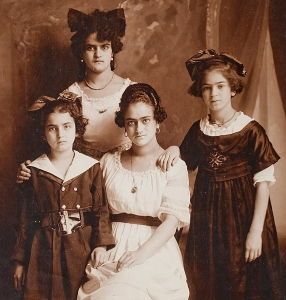
Aside from her mother's rigidity, religious fanaticism, and tendency toward outbursts, several other events in Kahlo's childhood affected her deeply. At age six, Kahlo contracted polio; a long recovery isolated her from other children and permanently damaged one of her legs, causing her to walk with a limp after recovery. Wilhelm, with whom Kahlo was very close, and particularly so after the experience of being an invalid, enrolled his daughter at the German College in Mexico City and introduced Kahlo to the writings of European philosophers such as Johann Wolfgang von Goethe, Friedrich Schiller, and Arthur Schopenhauer. All of Kahlo's sisters instead attended a convent school so it seems that there was a thirst for expansive learning noted in Frida that resulted in her father making different decisions especially for her. Kahlo was grateful for this and despite a strained relationship with her mother, always credited her father with great tenderness and insight. Still, she was interested in both strands of her roots, and her mixed European and Mexican heritage provided life-long fascination in her approach towards both life and art.
Kahlo had a horrible experience at the German School where she was sexually abused and thus forced to leave. Luckily at the time, the Mexican Revolution and the Minister of Education had changed the education policy, and from 1922 girls were admitted to the National Preparatory School. Kahlo was one of the first 35 girls admitted and she began to study medicine, botany, and the social sciences. She excelled academically, became very interested in Mexican culture, and also became active politically.
Early Training
When Kahlo was 15, Diego Rivera (already a renowned artist) was painting the Creation mural (1922) in the amphitheater of her Preparatory School. Upon seeing him work, Kahlo experienced a moment of infatuation and fascination that she would go on to fully explore later in life. Meanwhile she enjoyed helping her father in his photography studio and received drawing instruction from her father's friend, Fernando Fernandez - for whom she was an apprentice engraver. At this time Kahlo also befriended a dissident group of students known as the "Cachuchas", who confirmed the young artist's rebellious spirit and further encouraged her interest in literature and politics. In 1923 Kahlo fell in love with a fellow member of the group, Alejandro Gomez Arias, and the two remained romantically involved until 1928. Sadly, in 1925 together with Alejandro (who survived unharmed) on their way home from school, Kahlo was involved in a near-fatal bus accident.
Kahlo suffered multiple fractures throughout her body, including a crushed pelvis, and a metal rod impaled her womb. She spent one month in the hospital immobile, and bound in a plaster corset, and following this period, many more months bedridden at home. During her long recovery she began to experiment in small-scale autobiographical portraiture, henceforth abandoning her medical pursuits due to practical circumstances and turning her focus to art.
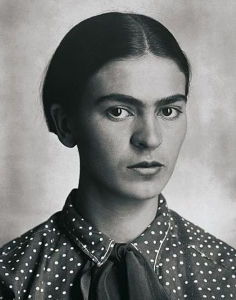
During the months of convalescence at home Kahlo's parents made her a special easel, gave her a set of paints, and placed a mirror above her head so that she could see her own reflection and make self-portraits. Kahlo spent hours confronting existential questions raised by her trauma including a feeling of dissociation from her identity, a growing interiority, and a general closeness to death. She drew upon the acute pictorial realism known from her father's photographic portraits (which she greatly admired) and approached her own early portraits (mostly of herself, her sisters, and her school friends) with the same psychological intensity. At the time, Kahlo seriously considered becoming a medical illustrator during this period as she saw this as a way to marry her interests in science and art.
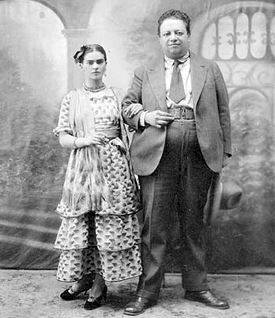
By 1927, Kahlo was well enough to leave her bedroom and thus re-kindled her relationship with the Cachuchas group, which was by this point all the more political. She joined the Mexican Communist Party (PCM) and began to familiarize herself with the artistic and political circles in Mexico City. She became close friends with the photojournalist Tina Modotti and Cuban revolutionary Julio Antonio Mella. It was in June 1928, at one of Modotti's many parties, that Kahlo was personally introduced to Diego Rivera who was already one of Mexico's most famous artists and a highly influential member of the PCM. Soon after, Kahlo boldly asked him to decide, upon looking at one of her portraits, if her work was worthy of pursuing a career as an artist. He was utterly impressed by the honesty and originality of her painting and assured her of her talents. Despite the fact that Rivera had already been married twice, and was known to have an insatiable fondness for women, the two quickly began a romantic relationship and were married in 1929. According to Kahlo's mother, who outwardly expressed her dissatisfaction with the match, the couple were 'the elephant and the dove'. Her father however, unconditionally supported his daughter and was happy to know that Rivera had the financial means to help with Kahlo's medical bills. The new couple moved to Cuernavaca in the rural state of Morelos where Kahlo devoted herself entirely to painting.
Mature Period
By the early 1930s, Kahlo's painting had evolved to include a more assertive sense of Mexican identity, a facet of her artwork that had stemmed from her exposure to the modernist indigenist movement in Mexico and from her interest in preserving the revival of Mexicanidad during the rise of fascism in Europe. Kahlo's interest in distancing herself from her German roots is evidenced in her name change from Frieda to Frida, and furthermore in her decision to wear traditional Tehuana costume (the dress from earlier matriarchal times). At the time, two failed pregnancies augmented Kahlo's simultaneously harsh and beautiful representation of the specifically female experience through symbolism and autobiography.
During the first few years of the 1930s Kahlo and Rivera lived in San Francisco, Detroit, and New York whilst Rivera was creating various murals. Kahlo also completed some seminal works including Frieda and Diego Rivera (1931) and Self-Portrait on the Borderline between Mexico and The United States (1932) with the latter expressing her observations of rivalry taking place between nature and industry in the two lands. It was during this time that Kahlo met and became friends with Imogen Cunningham , Ansel Adams , and Edward Weston . She also met Dr. Leo Eloesser while in San Francisco, the surgeon who would become her closest medical advisor until her death.
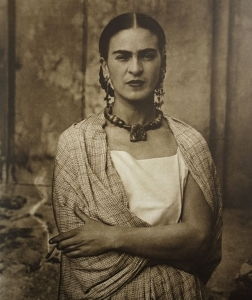
Soon after the unveiling of a large and controversial mural that Rivera had made for the Rockefeller Centre in New York (1933), the couple returned to Mexico as Kahlo was feeling particularly homesick. They moved into a new house in the wealthy neighborhood of San Angel. The house was made up of two separate parts joined by a bridge. This set up was appropriate as their relationship was undergoing immense strain. Kahlo had numerous health issues while Rivera, although he had been previously unfaithful, at this time had an affair with Kahlo's younger sister Cristina which understandably hurt Kahlo more than her husband's other infidelities. Kahlo too started to have her own extramarital affairs at this point. Not long after returning to Mexico from the States, she met the Hungarian photographer Nickolas Muray, who was on holiday in Mexico. The two began an on-and-off romantic affair that lasted 10 years, and it is Muray who is credited as the man who captured Kahlo most colorfully on camera.
While briefly separated from Diego following the affair with her sister and living in her own flat away from San Angel, Kahlo also had a short affair with the Japanese-American sculptor Isamu Noguchi . The two highly politically and socially conscious artists remained friends until Kahlo's death.
In 1936, Kahlo joined the Fourth International (a Communist organization) and often used La Casa Azul as a meeting point for international intellectuals, artists, and activists. She also offered the house where the exiled Russian Communist leader Leon Trotsky and his wife, Natalia Sedova, could take up residence once they were granted asylum in Mexico. In 1937, as well as helping Trotsky, Kahlo and the political icon embarked on a short love affair. Trotsky and his wife remained in La Casa Azul until mid-1939.
During a visit to Mexico City in 1938, the founder of Surrealism , André Breton , was enchanted with Kahlo's painting, and wrote to his friend and art dealer, Julien Levy , who quickly invited Kahlo to hold her first solo show at his gallery in New York. This time round, Kahlo traveled to the States without Rivera and upon arrival caused a huge media sensation. People were attracted to her colorful and exotic (but actually traditional) Mexican costumes and her exhibition was a success. Georgia O'Keeffe was one of the notable guests to attend Kahlo's opening. Kahlo enjoyed some months socializing in New York and then sailed to Paris in early 1939 to exhibit with the Surrealists there. That exhibition was not as successful and she became quickly tired of the over-intellectualism of the Surrealist group. Kahlo returned to New York hoping to continue her love affair with Muray, but he broke off the relationship as he had recently met somebody else. Thus Kahlo traveled back to Mexico City and upon her return Rivera requested a divorce.
Later Years and Death
Following her divorce, Kahlo moved back to La Casa Azul. She moved away from her smaller paintings and began to work on much larger canvases. In 1940 Kahlo and Rivera remarried and their relationship became less turbulent as Kahlo's health deteriorated. Between the years of 1940-1956, the suffering artist often had to wear supportive back corsets to help her spinal problems, she also had an infectious skin condition, along with syphilis. When her father died in 1941, this exacerbated both her depression and her health. She again was often housebound and found simple pleasure in surrounding herself by animals and in tending to the garden at La Casa Azul.
Meanwhile, throughout the 1940s, Kahlo's work grew in notoriety and acclaim from international collectors, and was included in several group shows both in the United States and in Mexico. In 1943, her work was included in Women Artists at Peggy Guggenheim's Art of This Century Gallery in New York. In this same year, Kahlo accepted a teaching position at a painting school in Mexico City (the school known as La Esmeralda ), and acquired some highly devoted students with whom she undertook some mural commissions. She struggled to continue making a living from her art, never accommodating to clients' wishes if she did not like them, but luckily received a national prize for her painting Moses (1945) and then The Two Fridas painting was bought by the Museo de Arte Moderno in 1947. Meanwhile, the artist grew progressively ill. She had a complicated operation to try and straighten her spine, but it failed and from 1950 onwards, she was often confined to a wheelchair.
She continued to paint relatively prolifically in her final years while also maintaining her political activism, and protesting nuclear testing by Western powers. Kahlo exhibited one last time in Mexico in 1953 at Lola Alvarez Bravo's gallery, her first and only solo show in Mexico. She was brought to the event in an ambulance, with her four-poster bed following on the back of a truck. The bed was then placed in the center of the gallery so that she could lie there for the duration of the opening. Kahlo died in 1954 at La Casa Azul. While the official cause of death was given as pulmonary embolism, questions have been raised about suicide - either deliberate of accidental. She was 47 years old.
The Legacy of Frida Kahlo
As an individualist who was disengaged from any official artistic movement, Kahlo's artwork has been associated with Primitivism , Indigenism , Magic Realism , and Surrealism . Posthumously, Kahlo's artwork has grown profoundly influential for feminist studies and postcolonial debates, while Kahlo has become an international cultural icon. The artist's celebrity status for mass audiences has at times resulted in the compartmentalization of the artist's work as representative of interwar Latin American artwork at large, distanced from the complexities of Kahlo's deeply personal subject matter. Recent exhibitions, such as Unbound: Contemporary Art After Frida Kahlo (2014) at the Museum of Contemporary Art Chicago have attempted to reframe Kahlo's cultural significance by underscoring her lasting impact on the politics of the body and Kahlo's challenge to mainstream aesthetics of representation. Dreamers Awake (2017) held at The White Cube Gallery in London further illustrated the huge influence that Frida Kahlo and a handful of other early female Surrealists have had on the development and progression of female art.
The legacy of Kahlo cannot be underestimated or exaggerated. Not only is it likely that every female artist making art since the 1950s will quote her as an influence, but it is not only artists and those who are interested in art that she inspires. Her art also supports people who suffer as result of accident, as result of miscarriage, and as result of failed marriage. Through imagery, Kahlo articulated experiences so complex, making them more manageable and giving viewers hope that they can endure, recover, and start again.
Influences and Connections

Useful Resources on Frida Kahlo
- Frida: A Biography of Frida Kahlo Our Pick By Hayden Herrera
- Frida Kahlo: Her Photos By Pablo Ortiz Monasterio
- Frida Kahlo: Making Her Self Up Our Pick By Claire Wilcox and Circe Henestrosa
- Frida Kahlo at Home Our Pick By Suzanne Barbezat
- Frida Kahlo: The Last Interview: and Other Conversations (The Last Interview Series) By Hayden Herrera
- Frida Kahlo I Paint My Reality By Christina Burrus
- Frida & Diego: Art, Love, Life By Cateherine Reef
- The Diary of Frida Kahlo: An Intimate Self-Portrait Our Pick By Carlos Fuentes
- Frida by Frida By Frida Kahlo and Raquel Tibol
- Frida Kahlo: The Paintings Our Pick By Hayden Herrera
- Frida Kahlo By Emma Dexter, Tanya Barson
- Frida Kahlo Retrospective By Peter von Becker, Ingried Brugger, Salamon Grimberg, Cristina Kahlo, Arnaldo Kraus, Helga Prignitz-Poda, Francisco Reyes Palma, Florian Steininger, Jeanette Zqingenberger
- Frida Kahlo Masterpieces of Art By Julian Beecroft
- Kahlo (Basic Art Series 2.0) Our Pick By Andrea Kettenmann
- Frida Kahlo's Gadren Our Pick By Adriana Zavala
- The Museum of Modern Art: Discussion of Portrait with Cropped Hair by Frida Kahlo
- Frida Kahlo: The woman behind the legend - TED_Ed
- Frida Kahlo's 'The Two Fridas” - Great Art Explained Our Pick
- Frida Kahlo: Life of an Artist - Art History School Our Pick
- A Tour of Frida Kahlo’s Blue House – La Casa Azul
- La Casa Azul - Museo Frida Kahlo in Mexico City Our Pick The artist's house museum
- Works from La Casa Azul - Museo Frida Kahlo in Mexico City Our Pick By The Google Cultural Institute
- Frida Kahlo at the Tate Modern Website of the 2005 Exhibition
- Why Contemporary Art Is Unimaginable Without Frida Kahlo By Priscilla Frank / The Huffington Post / April 29, 2014
- Diary of a Mad Artist By Amy Fine Collins / Vanity Fair / July 2011
- The People's Artist, Herself a Work of Art Our Pick By Holland Cotter / The New York Times / February 29, 2008
- Let Fridamania Commence By Adrian Searle / The Guardian / June 6, 2005
- The Trouble with Frida Kahlo By Stephanie Mencimer / Washington Monthly / June 2002
- Frida Kahlo: A Contemporary Feminist Reading Our Pick By Liza Bakewell / Frontiers: A Journal of Women Studies / 1993
- Frida Kahlo: Portrait of Chronic Pain By Carol A. Courtney, Michael A. O'Hearn, and Carla C. Franck / Physical Therapy / January 2017
- Medical Imagery in the Art of Frida Kahlo Our Pick By David Lomas, Rosemary Howell / British Medical Journal / December 1989
- Fashioning National Identity: Frida Kahlo in “Gringolandia" Our Pick By Rebecca Block and Lynda Hoffman-Jeep / Women’s Art Journal / 1999
- Art Critics on Frida Kahlo: A Comparison of Feminist and Non-Feminist Voices By Elizabeth Garber / Art Education / March 1992
- NPR: Mexican Artist Used Politics to Rock the Boat Artist Judy Chicago discusses the book she co-authored: "Frida Kahlo: Face to Face"
- Frida Our Pick A 2002 Biographical Film on Frida Kahlo, Starring Salma Hayek
- The Frida Kahlo Corporation A Company with Products Inspired by Frida Kahlo
- How Frida Kahlo Became a Global Brand By Tess Thackara / Artsy.com / Dec 19, 2017 /
Similar Art

Portrait of Lupe Marin (1938)

Egg in the church or The Snake (Date Unknown)

Self-Portrait (c. 1937-38)

Einhorn (Unicorn) (1970-72)
Related artists.

Related Movements & Topics

Content compiled and written by Katlyn Beaver
Edited and revised, with Summary and Accomplishments added by Rebecca Baillie
- Earth and Environment
- Literature and the Arts
- Philosophy and Religion
- Plants and Animals
- Science and Technology
- Social Sciences and the Law
- Sports and Everyday Life
- Additional References

- Latin American Art: Biographies
Frida Kahlo
Frida Kahlo (1907-1954) was a Mexican painter often associated with the European Surrealists as well as with her husband, Mexican muralist Diego Rivera . She was noted for her intense autobiographical paintings.
Frida Kahlo, was born in Coyoacán, a suburb of Mexico City , in 1907, the daughter of a German-Jewish photographer and an Indian-Spanish mother. Despite her European background, Kahlo identified all her life with New World, Mexican heritage, dressing in native clothing wherever she travelled. Injured in a bus accident at the age of 15, Kahlo was disabled for life. After numerous operations to correct her spinal and internal injuries, she eventually became an invalid prior to her death at the age of 47. Like her husband, the muralist Diego Rivera , Kahlo maintained a life-long commitment to leftist politics, and in the 1930s she accompanied him on several trips to the United States where he was commissioned to do murals in New York , Detroit, and San Francisco . The most controversial of these was a mural for Rockefeller Center which was cancelled because it included a portrait of Lenin that Rivera refused to remove. Kahlo died in Mexico City in 1954.
Unlike Rivera's murals, which were grandiose and filled with political ideology, Kahlo's work was intimate, personal, and in the tradition of easel painting. Usually autobiographical, she painted the events of her life with symbolic elements and situations, creating a dreamlike reality, frighteningly real but fantastic and magical. One painting, Broken Column (1944), shows the artist against a bleak desert landscape with her flesh cut away to reveal a cracked classical column in place of her spine, a painful record of her life-long struggle with the psychological and physical aftermath of her accident. Another, The Wounded Deer (1946), shows Kahlo as a deer with her own human head, shot full of arrows in a mysteriously forlorn forest with a body of water in the background. She painted many self-portraits throughout her life.
Kahlo incorporated elements of Mexican folk art into her paintings. Thematic content often takes precedence over a fidelity to realism, and the scale of things represents symbolic relationships rather than physical ones. Reoccurring themes of earthly suffering and the redemptive cycle of nature reflect the mixture of Spanish Catholicism and Indian religion prominent in Mexican culture. Kahlo's color, while naturalistic, is flat and dramatic.
The French Surrealist poet Andre Breton , who lived for a while in Mexico, claimed Kahlo as a Surrealist. She bristled at this association with artists living thousands of miles away and working with psychoanalytic theories of the subconscious. She claimed, "Breton thought I was a Surrealist but I wasn't. I never painted dreams. I painted my own reality." She did, however, show at the Julian Levy Gallery in New York , known for showing Surrealism, and she travelled to Paris at Breton's urging to show her work.
Early in her life her work and reputation as an artist were overshadowed by her relationship to Rivera, who was older and famous before they met. She also seemed conflicted by her sense of duty to him as a wife. In the late 1930s she asserted her independence from him, and in 1939 they were divorced, only to be remarried a short time later. This event served as an important theme in her work of the period. In contrast to Rivera, who was relatively wealthy from his work, Kahlo had great difficulties supporting herself from the sale of her paintings.
Together they led a flamboyant life in Mexico and during their trips to the United States . They were at the center of Mexican cultural life in the 1920s and 1930s when Mexican artists and intellectuals were rediscovering their own heritage and rejecting European ties. This desire for a Mexican art came in part from an interest in leftist politics. Kahlo was a life-time member of the Communist Party , which believed that art should serve the Mexican masses rather than a European elite. Unlike Rivera, Kahlo was not a muralist, but later in her life, when she was asked to teach in an important state art school, she organized teams of students to execute public works.
During her life Frida Kahlo received more recognition as a painter in the United States than in Mexico. She was included in several important group exhibitions, including "Twenty Centuries of Mexican Art" at the Museum of Modern Art and a show of women artists at Peggy Guggenheim 's Art of This Century Gallery in New York. Her first one-person show in Mexico at the Galeria Arte Contemporaneo occurred only one year before her death and in part because her death was anticipated. After her death in 1954 her reputation grew in Mexico and diminished in the United States, a time when communists and their sympathizers were discredited. Diego Rivera himself is less known in the United States now than in the 1930s.
Like many prominent women artists of her generation, such as Louise Nevelson and Georgia O'Keefe, Frida Kahlo's art was individualistic and stood apart from mainstream work. They were often overlooked by critics and historians because they were women and outsiders and because their art was difficult to fit into movements and categories. Kahlo has received increased attention since the 1970s as objections to her politics have softened and as interest grows about the role of women artists and intellectuals in history. Concepts of modernism are also being expanded to encompass an uninterrupted strain of figurative art throughout the 20th century, into which Kahlo's painting smoothly fits. Frida Kahlo was the subject of major retrospective exhibitions in the United States in 1978-1979 and in 1983 and in England in 1982.
Further Reading
Hayden Herrera published Frida: A Biography of Frida Kahlo (1983), an extensive work that focuses on her life. Her painting is discussed more historically and critically in Whitney Chadwick's Women Artists and the Surrealist Movement (1985), which focuses on women artists who worked within Surrealist circles but were seldom recorded in its history. □
Cite this article Pick a style below, and copy the text for your bibliography.
" Frida Kahlo . " Encyclopedia of World Biography . . Encyclopedia.com. 18 Mar. 2024 < https://www.encyclopedia.com > .
"Frida Kahlo ." Encyclopedia of World Biography . . Encyclopedia.com. (March 18, 2024). https://www.encyclopedia.com/history/encyclopedias-almanacs-transcripts-and-maps/frida-kahlo
"Frida Kahlo ." Encyclopedia of World Biography . . Retrieved March 18, 2024 from Encyclopedia.com: https://www.encyclopedia.com/history/encyclopedias-almanacs-transcripts-and-maps/frida-kahlo
Citation styles
Encyclopedia.com gives you the ability to cite reference entries and articles according to common styles from the Modern Language Association (MLA), The Chicago Manual of Style, and the American Psychological Association (APA).
Within the “Cite this article” tool, pick a style to see how all available information looks when formatted according to that style. Then, copy and paste the text into your bibliography or works cited list.
Because each style has its own formatting nuances that evolve over time and not all information is available for every reference entry or article, Encyclopedia.com cannot guarantee each citation it generates. Therefore, it’s best to use Encyclopedia.com citations as a starting point before checking the style against your school or publication’s requirements and the most-recent information available at these sites:
Modern Language Association
http://www.mla.org/style
The Chicago Manual of Style
http://www.chicagomanualofstyle.org/tools_citationguide.html
American Psychological Association
http://apastyle.apa.org/
- Most online reference entries and articles do not have page numbers. Therefore, that information is unavailable for most Encyclopedia.com content. However, the date of retrieval is often important. Refer to each style’s convention regarding the best way to format page numbers and retrieval dates.
- In addition to the MLA, Chicago, and APA styles, your school, university, publication, or institution may have its own requirements for citations. Therefore, be sure to refer to those guidelines when editing your bibliography or works cited list.
More From encyclopedia.com
About this article, related topics, you might also like.
- Kahlo, Frida: 1907—1954: Artist
- Kahlo, Frida (1907–1954)
- Guerrero, Xavier (1896–1975)
- Romero, Alejandro: 1948—: Painter and Muralist
- Kahlo, Frida 1907–1954
- Mexican art and architecture
- Retablos and Ex-Votos
NEARBY TERMS

My painting carries with it the message of pain.
- Frida Kahlo
Frida Kahlo and her paintings
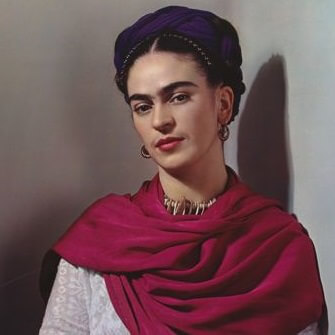
Mexican artist Frida Kahlo is remembered for her self-portraits, pain and passion, and bold, vibrant colors. She is celebrated in Mexico for her attention to Mexican and indigenous culture and by feminists for her depiction of the female experience and form.
Kahlo, who suffered from polio as a child, nearly died in a bus accident as a teenager. She suffered multiple fractures of her spine, collarbone and ribs, a shattered pelvis, broken foot and a dislocated shoulder. She began to focus heavily on painting while recovering in a body cast. In her lifetime, she had 30 operations.
Life experience is a common theme in Kahlo's approximately 200 paintings, sketches and drawings. Her physical and emotional pain are depicted starkly on canvases, as is her turbulent relationship with her husband, fellow artist Diego Rivera , who she married twice. Of her 143 paintings, 55 are self-portraits.
The devastation to her body from the bus accident is shown in stark detail in The Broken Column . Kahlo is depicted nearly naked, split down the middle, with her spine presented as a broken decorative column. Her skin is dotted with nails. She is also fitted with a surgical brace.
Kahlo's first self-portrait was Self-Portrait in a Velvet Dress in 1926. It was painted in the style of 19th Century Mexican portrait painters who themselves were greatly influenced by the European Renaissance masters. She also sometimes drew from the Mexican painters in her use of a background of tied-back drapes. Self-Portrait - Time Flies (1929), Portrait of a Woman in White (1930) and Self-Portrait Dedicated to Leon Trotsky (1937) all bear this background.
I paint self-portraits because I am so often alone, because I am the person I know best." - Frida Kahlo
In her second-self portrait, "Time Flies," Kahlo uses a folk style and vibrant colors. She wears peasant clothing, and the red, white and green in the painting are the colors of the Mexican flag.
During her life, self portrait is a subject that Frida Kahlo always returns to, as artists have always returned to their beloved themes - Rembrandt his Self Portrait , Vincent van Gogh his Sunflowers , and Claude Monet his Water Lilies .
Frida and Diego: Love and Pain
Kahlo and Rivera had a tumultuous relationship, marked by multiple affairs on both sides. Self-Portrait With Cropped Hair (1940), Kahlo is depicted in a man's suit, holding a pair of scissors, with her fallen hair around the chair in which she sits. This represents the times she would cut the hair Rivera loved when he had affairs.
The 1937 painting Memory, the Heart , shows Kahlo's pain over her husband's affair with her younger sister Christina. A large broken heart at her feet shows the intensity of Kahlo's anguish. Frida Kahlo and Diego Rivera divorced in 1939, but reunited a year later and remarried. The Two Fridas (1939) depicts Kahlo twice, shortly after the divorce. One Frida wears a costume from the Tehuana region of Mexico, representing the Frida that Diego loved. The other Frida wears a European dress as the woman who Diego betrayed and rejected. Later, she is back in Tehuana dress in Self-Portrait as a Tehuana (1943) and Self Portrait (1948).
Pre-Columbian artifacts were common both in the Kahlo/Rivera home (Diego collected sculptures and idols, and Frida collected Jewelry) and in Kahlo's paintings. She wore jewelry from this period in Self-Portrait - Time Flies (1926), Self-Portrait With Monkey (1938) and Self-Portrait With Braid (1941), among others. Other Pre-Columbian artifacts are found in The Four Inhabitants of Mexico City (1938), Girl With Death Mask (1938) and Self-Portrait With Small Monkeys (1945).
My painting carries with it the message of pain." - Frida Kahlo
Surreal or Realist?
Frida Kahlo participated in the "International Exhibition of Surrealism" in 1940 at the Galeria de Arte, Mexicano. There, she exhibited her two largest paintings: The Two Fridas and The Wounded Table (1940). Surrealist Andrew Breton considered Kahlo a surrealistic, a label Kahlo rejected, saying she just painted her reality. However, In 1945, when Don Jose Domingo Lavin asked Frida Kahlo to read the book Moses and Monotheism by Sigmund Freud - whose psychoanalysis works Surrealism is based on - and paint her understanding and interpretation of this book. Frida Kahlo painted Moses , and this painting was recognized as second prize at the annual art exhibition in the Palacio de Bellas Artes.
Kahlo did not sell many paintings in her lifetime, although she painted occasional portraits on commission. She had only one solo exhibition in Mexico in her lifetime, in 1953, just a year before her death at the age of 47.
Today, her works sell for very high prices. In May 2006, Frida Kahlo self-portrait, Roots , was sold for $5.62 million at a Sotheby's auction in New York, sets a record as the most expensive Latin American work ever purchased at auction, and also makes Frida Kahlo one of the highest-selling woman in art.
Widely known for her Marxist leanings, Frida, along with Marxism Revolutionary Che Guevara and a small band of contemporary figures, has become a countercultural symbol of the 20th century, and created a legacy in art history that continues to inspire the imagination and mind. Born in 1907, dead at 47, Frida Kahlo achieved celebrity even in her brief lifetime that extended far beyond Mexico's borders, although nothing like the cult status that would eventually make her the mother of the selfie, her indelible image recognizable everywhere.
At the Frida Kahlo Museum in Mexico City, her personal belongings are on display throughout the house, as if she still lived there. Kahlo was born and grew up in this building, whose cobalt walls gave way to the nickname of the Blue House. She lived there with her husband for some years, and she died there. The facility is the most popular museum in the Coyoacan neighborhood and among the most visited in Mexico City.
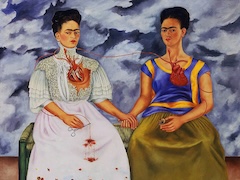
The Two Fridas
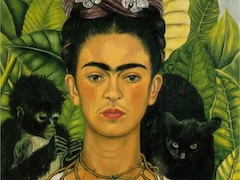
Self-Portrait with Thorn Necklace & Hummingbird
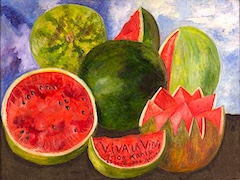
Viva la Vida, Watermelons
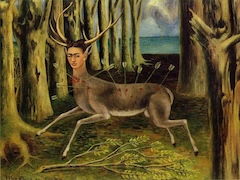
The Wounded Deer
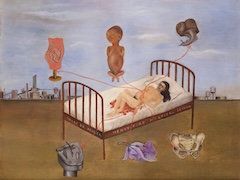
Henry Ford Hospital
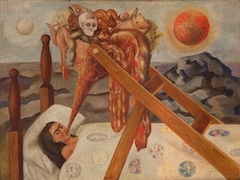
Without Hope
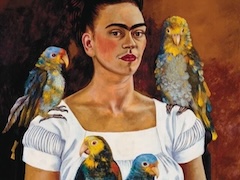
Me and My Parrots
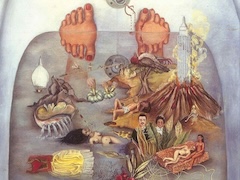
What the Water Gave Me

Frida and Diego Rivera
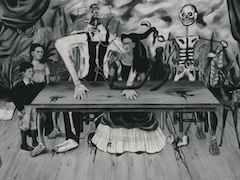
The Wounded Table
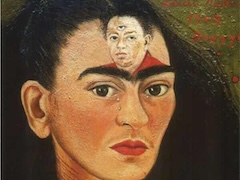
Diego and I
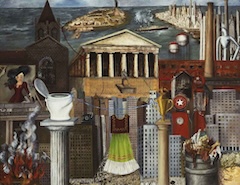
My Dress Hangs There
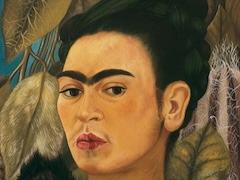
Self Portrait with Monkey
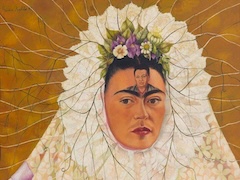
Self Portrait as a Tehuana
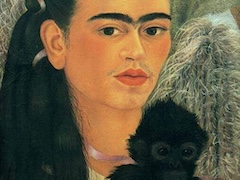
Fulang Chang and I
If you're seeing this message, it means we're having trouble loading external resources on our website.
If you're behind a web filter, please make sure that the domains *.kastatic.org and *.kasandbox.org are unblocked.
To log in and use all the features of Khan Academy, please enable JavaScript in your browser.
Modernisms 1900-1980
Course: modernisms 1900-1980 > unit 7, frida kahlo, introduction.
- Frida Kahlo, Frieda and Diego Rivera
- Kahlo, The Two Fridas (Las dos Fridas)
- Kahlo, The Two Fridas
- Frida Kahlo, Self-Portrait with Monkey
- Rosa Rolanda, Self-Portrait
- Wifredo Lam, The Eternal Presence
- Lam, The Jungle
- Hector Hyppolite, Ogou Feray also known as Ogoun Ferraille
- Latin American Modernism

The Two Fridas
Self-portrait with cropped hair.
- Adriana Zavala, Becoming Modern, Becoming Tradition: Women, Gender, and Representation in Mexican Art (Pennsylvania State University Press, 2009), p. 3
Want to join the conversation?
Encyclopedia of Humanities
The most comprehensive and reliable Encyclopedia of Humanities
Frida Kahlo
We explain who Frida Kahlo was, and explore her childhood and the development of her works. In addition, we discuss her style and death.
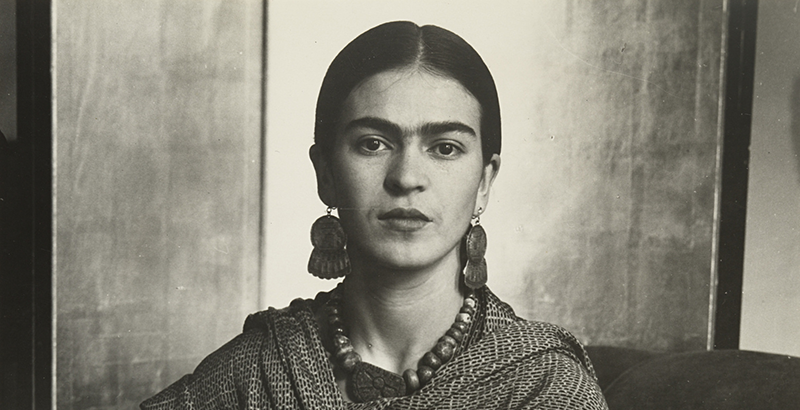
Who was Frida Kahlo?
Frida Kahlo, original name Magdalena Carmen Frida Kahlo y Calderón, was a Mexican painter born in Coyoacán on July 6, 1907 . She died on July 13, 1954.
As a child, Frida contracted polio and, at the age of 18, she suffered a severe bus accident that nearly took her life . As a result, she had to undergo 32 surgeries over the years. The hardships she faced are vividly reflected in her artwork.
She was the wife of renowned Mexican painter Diego Rivera , who introduced her to the circle of the most prominent artists of the time, and received acclaim from notable art figures such as Marcel Duchamp, André Breton, Wassily Kandinsky, and Pablo Picasso.
Frida Kahlo’s works also convey her political and social commitment. Widespread recognition came posthumously , especially from the 1970s onward, and she is now regarded as one of the major artists in Latin America .
- See also: Eva Perón
Birth and childhood of Frida Kahlo
Frida Kahlo was born in Coyoacán, Mexico, on July 6, 1907. Her father, German photographer Guillermo Kahlo, was of Hungarian-Jewish descent, and her mother, Matilde Calderón, was Mexican of Spanish and indigenous ancestry, born in Mexico City.
As a child, Frida learned to develop, retouch, and color photographs under her father's guidance , which later influenced her passion for painting.
At the age of six, she contracted polio , and her father took care of her during the six months of her recovery. As a consequence of the disease, she was afflicted with a limp throughout her life.
Accident and painting of Frida Kahlo
In 1922, Frida entered the National Preparatory School in Mexico City, her intention being to study medicine. However, on September 17, 1925, the bus in which she was traveling collided with a streetcar , and Frida was severely injured.
Although she managed to survive, she suffered multiple injuries that would shape her life. Her spine suffered several fractures and, over the years, she underwent over 30 surgeries and had to wear plaster corsets. During the initial months of convalescence, she was bedridden; she abandoned the idea of studying medicine and began painting . In 1926, she painted her first self-portrait.
Frida Kahlo and the Communist Party
Two years after the accident, Frida had recovered sufficiently to reconnect with friends and associate with personalities in the fields of art, thought, and politics. She identified with a cultural movement seeking to recover elements of the Mexican popular tradition , including indigenous influences.
In 1928, her friend Germán del Campo introduced her to Cuban communist leader Julio Antonio Mella, who was in exile in Mexico with his partner, Italian photographer Tina Modotti. Frida began attending meetings of the Mexican Communist Party and became romantically involved with Diego Rivera, who had been a member of the party since 1922.
Following a stay in the United States between 1930 and 1933 with Rivera, whom she had married in 1929, she returned to Mexico City. Between 1937 and 1939, she provided refuge to Russian communist exile Leon Trotsky , persecuted by the Stalinist government, who was eventually assassinated in 1940.
Frida maintained her adherence to communism for the rest of her life . Upon her death, her coffin was draped with the flag of the Mexican Communist Party.
Frida Kahlo's marriage to Diego Rivera
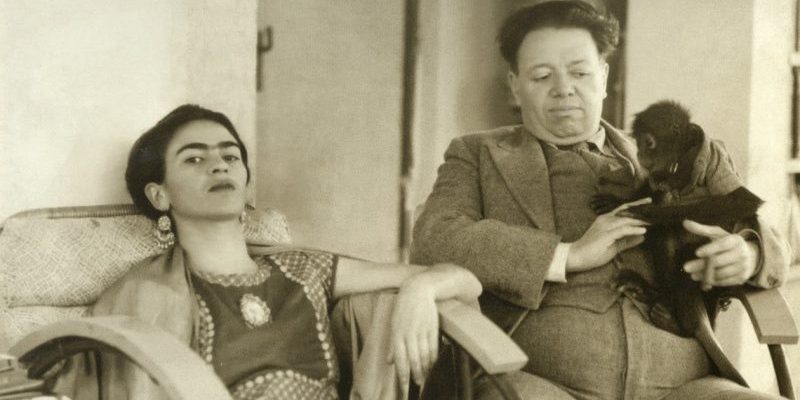
Frida met muralist Diego Rivera in 1922 , when he was painting a mural at the National Preparatory School she attended. However, their romantic relationship only began in 1928 when they were introduced by communist activists Julio Antonio Mella and Tina Modotti.
Frida shared her artwork with Rivera, who encouraged her to continue painting. They married in 1929. She was 22 years old and he was 42 . The marriage was tumultuous, marred by extramarital affairs from both parties, most notably Rivera's relationship with Frida's younger sister, which led to their divorce in 1939. However, they remarried at the end of 1940.
Frida's relationship with Rivera influenced not only her artistic style but also the way she dressed. She usually wore colorful garments characteristic of indigenous women in some regions of Mexico, particularly the Tehuana dresses, which pleased her husband. These included necklaces, ornamental combs, or flower headdresses, which became a hallmark of Frida Kahlo's image.
Attempts at motherhood and death
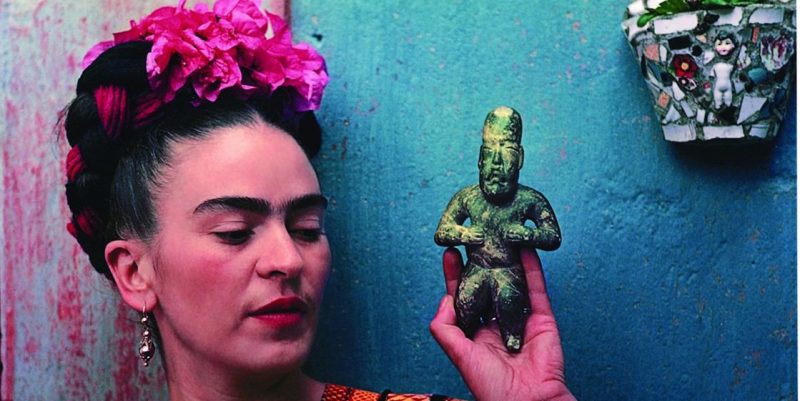
Frida became pregnant with Rivera's child on three occasions but, due to her health problems, she lost each pregnancy . Some of her artwork conveys her thwarted desire for motherhood and the pain from the lost pregnancies.
Throughout her life, Frida continued to suffer from ailments and medical treatments. Her health deteriorated towards 1950, and she eventually died on July 13, 1954 at the age of 47 , due to a pulmonary embolism. Some versions suggested it might have been a suicide, but no evidence has ever appeared to support this theory.
She had expressed her wish not to be buried , on the grounds that she had been bedridden for many years. Her body was cremated and her ashes were placed in a pre-Columbian urn at The Blue House (La Casa Azul) in Coyoacán, where she had lived most of her life and which today houses the Frida Kahlo Museum.
The Blue House
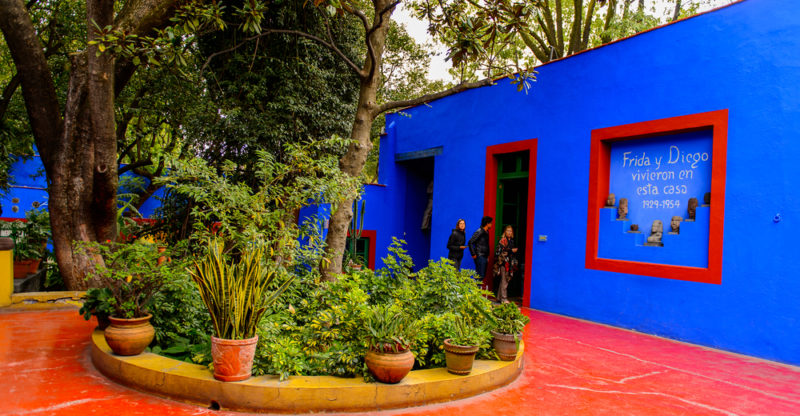
In the famous Blue House (La Casa Azul) in Coyoacán (Mexico City), on the corner of Londres and Allende streets , Frida Kahlo was born, grew up, and produced much of her great artistic work.
Diego Rivera also lived in this house during the time they were married, and it was frequented by artists and intellectuals . Moreover, the Blue House sheltered communist militant refugees, among them Leon Trotsky and his wife.
Following Frida's death, the Blue House and its gardens became home to the Frida Kahlo Museum , which opened on July 12, 1958. Today, it exhibits paintings and personal objects of Frida Kahlo and Diego Rivera, as well as documents, books, furniture, dresses, and pre-Columbian sculptures that were the environment in which Frida created her works.
The work of Frida Kahlo
Her artistic style.
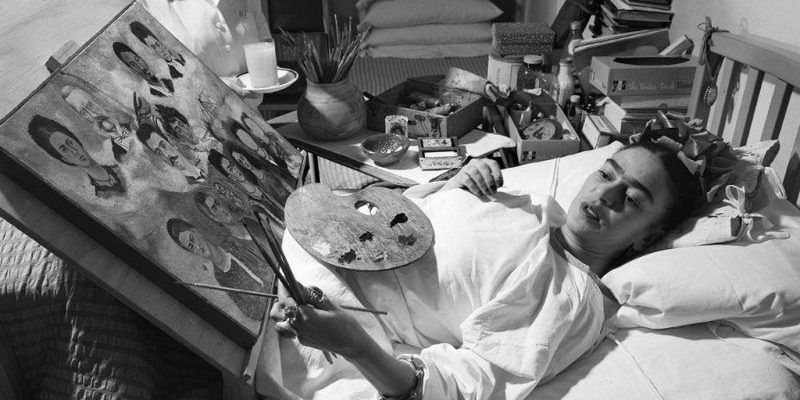
Frida Kahlo's art largely consisted of paintings that conveyed the suffering and torments she experienced throughout her life. She painted numerous self-portraits in which she crudely expressed her personal experiences and also distanced herself from the artistic stereotypes about femininity, which later influenced her image's revival by feminist movements after her death.
In her nearly 200 works, in addition to self-portraits, she painted still lifes and touched upon social and political themes . Her art often portrayed Mexican folklore since, like many artists and intellectuals following the Mexican Revolution, she was concerned with rescuing aspects of Mexican folk art.
She also incorporated into her art symbolism and images from the recent history of communism , which had made an international impact after the Bolshevik revolution of 1917 and whose ideology was embraced by Frida.
Frida Kahlo's style is difficult to classify. On one occasion, her work was defined as surrealist , which she rejected claiming that her art dealt with her own real life. She has also been associated with primitivism and expressionism.
Her most renowned works include Self-Portrait in a Velvet Dress (1926), Henry Ford Hospital (1932), The Frame (1938), The Two Fridas (1939), The Broken Column (1944), Moses (1945), The Wounded Deer (1946), and Diego and I (1949).
Her color choice
In her works, Frida used bright vibrant colors, which became hallmarks of her style. According to the artist, the colors she used bore specific meanings:
- Good warm light.
- Blood (the red color in her paintings and some of her frames may have symbolized the blood she shed throughout her life: in the accident, surgeries, and miscarriages).
- Madness, fear, illness, mystery.
- Love, purity, electricity, distance, and tenderness.
Exhibition of her artworks
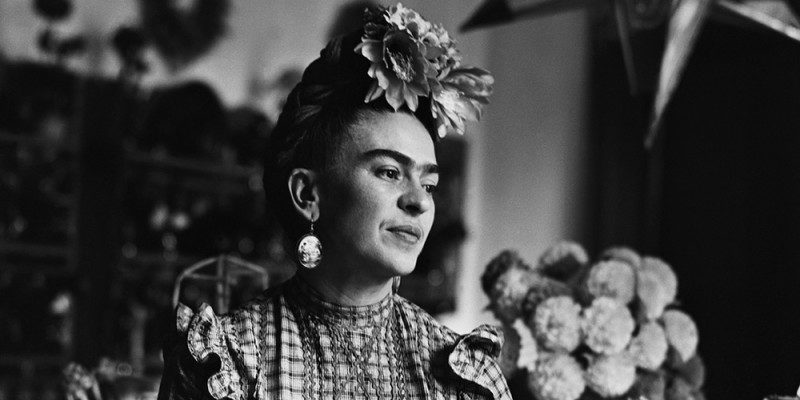
Frida Kahlo's first solo exhibition took place in November 1938 at the Julien Levy Gallery in New York. Her work had been promoted by surrealist writer André Breton , who had traveled to Mexico and had been impressed by her work. In 1939, she exhibited in Paris, and the Louvre Museum acquired her piece "The Frame" ( El marco ). In subsequent years, she exhibited in other cities, especially in the United States.
Frida had only one solo exhibition in her home country . On the opening day, April 13, 1953, her health was so deteriorated that her doctor advised against getting out of bed. Nonetheless, Frida chose to arrive by ambulance and attended the event lying on a hospital bed.
Following her death, and particularly from the 1970s onward, her work acquired widespread recognition, and her paintings have been exhibited in galleries and museums worldwide .
Explore next:
- Che Guevara
- Nelson Mandela
- Thales of Miletus
- Jean Monnet (1888-1979)
- Kahlo 1907-1954. Dolor y pasión . Kettenmann, A. (1999). Taschen.
- "Frida Khalo" en Museo Frida Kahlo .
- "Frida Kahlo. Un ícono del siglo XX" Sadurní, J. M. (2021) en Historia National Geographic .
- "Frida Kahlo" Zelazko, A. (2022) en Encyclopedia Britannica .
Was this information useful to you?
Updates? Omissions? Article suggestions? Send us your comments and suggestions
Thank you for visiting us :)
Biography of Frida Kahlo, Mexican Surrealist and Folk Art Painter
Her life was dramatized in a biopic nearly 50 years after her death
Ivan Dmitri / Michael Ochs Archives / Getty Images
- Important Figures
- History Of Feminism
- Women's Suffrage
- Women & War
- Laws & Womens Rights
- Feminist Texts
- American History
- African American History
- African History
- Ancient History and Culture
- Asian History
- European History
- Latin American History
- Medieval & Renaissance History
- Military History
- The 20th Century
- B.A., Mundelein College
- M.Div., Meadville/Lombard Theological School
Frida Kahlo (July 6, 1907–July 13, 1954), one of the few women painters that many can name, was known for her surrealistic paintings, including many emotionally intense self-portraits. Stricken with polio as a child and injured badly in an accident when she was 18, she struggled with pain and disability all her life. Her paintings reflect a modernist take on folk art and integrate her experience of suffering. Kahlo was married to artist Diego Rivera .
Fast Facts: Frida Kahlo
- Known For : Mexican surrealist and folk art painter
- Also Known As : Magdalena Carmen Frida Kahlo y Calderon, Frieda Kahlo, Frida Rivera, Mrs. Diego Rivera.
- Born : July 6, 1907 in Mexico City
- Parents : Matilde Calderón, Guillermo Kahlo
- Died : July 13, 1954 in Mexico City
- Education : National Preparatory School in Mexico City, entered 1922, studied medicine and medical illustration
- Famous Paintings : The Two Fridas (1939), Self Portrait with Cropped Hair (1940), Self-Portrait with Thorn Necklace and Hummingbird (1940)
- Awards and Honors : National Prize of Arts and Sciences (conferred by the Mexican Ministry of Public Education, 1946)
- Spouse : Diego Rivera (m. Aug. 21, 1929–1939, remarried 1940–1957)
- Children : None
- Notable Quote : "I paint my own reality. The only thing I know is that I paint because I need to, and I paint whatever passes through my head without any other consideration."
Kahlo was born in a suburb of Mexico City on July 6, 1907. She later claimed 1910 as her year of birth because 1910 was the beginning of the Mexican Revolution . She was close to her father but not so close to her often-depressed mother. She was struck with polio when she was about 6 years old and while the illness was mild, it did cause her right leg to be withered—which led to the twisting of her spine and pelvis.
She entered the National Preparatory School in 1922 to study medicine and medical illustration, adopting a native style of dress.
The Trolley Accident
In 1925, Kahlo was nearly fatally injured when a trolley collided with the bus on which she was riding. She broke her back, pelvis, collarbone, and two ribs, her right foot was crushed, and her right leg was broken in 11 places. A handrail of the bus impaled her in the abdomen. She had surgeries throughout her life to try to correct the disabling effects of the accident.
Diego Rivera and Marriage
During the convalescence from her accident, she began to paint. Self-taught, in 1928 Kahlo sought out Mexican painter Diego Rivera, more than 20 years her senior, whom she'd met when she was in preparatory school. She asked him to comment on her work, which relied on bright colors and Mexican folk images. She joined the Young Communist League, which Rivera headed.
In 1929, Kahlo married Rivera in a civil ceremony despite her mother's protests. The couple moved to San Francisco for a year in 1930. It was his third marriage and he had many affairs, including with Kahlo's sister Cristina. Kahlo, in turn, had her own affairs, with both men and women. One of her brief affairs was with American painter Georgia O'Keeffe.
She changed the spelling of her first name from Frieda, the German spelling, to Frida, the Mexican spelling, in the 1930s as a protest against fascism . In 1932, Kahlo and Rivera lived in Michigan, where Kahlo miscarried a pregnancy. She immortalized her experience in a painting titled, "Henry Ford Hospital."
From 1937–1939, Leon Trotsky lived with the couple. Kahlo had an affair with the Communist revolutionary. She was often in pain from her disabilities and emotionally distraught from the marriage, and probably addicted to painkillers for a long time. Kahlo and Rivera divorced in 1939, but then Rivera convinced her to remarry the next year. Kahlo made that marriage contingent on remaining sexually separate and on her financial self-support.
Art Success
Kahlo's first solo show was in New York City, in 1938, after Rivera and Kahlo had moved back to Mexico. She had another show in 1943, also in New York. Kahlo produced many paintings in the 1930s and 1940s, but it was not until 1953 that she finally had a one-woman show in Mexico. Her long struggle with her disabilities, however, had left her by this point an invalid, and she entered the exhibit on a stretcher and rested on a bed to receive visitors. Her right leg was amputated at the knee when it became gangrenous.
Kahlo died in Mexico City in 1954. Officially, she died of a pulmonary embolism, but some believe she deliberately overdosed on painkillers, welcoming an end to her suffering. Even in death, Kahlo was dramatic; when her body was being put into the crematorium, the heat caused her body to suddenly sit up.
Kahlo's work began to come to prominence in the 1970s. Much of her work is at the Museo Frida Kahlo (the Frida Kahlo Museum), also called the Blue House for its cobalt blue walls, which opened in 1958 in her former Mexico City residence. She is considered a forerunner to feminist art .
Indeed, Kahlo's life was depicted in the 2002 biopic, "Frida," starring Salma Hayek as the title character. The film received a 75 percent critic's score and an 85 percent audience score on the movie review-aggregation website Rotten Tomatoes. It also received six Academy Award nominations (winning for Best Makeup and Best Original Score), including Hayek's nomination in the Best Actress category for her dramatic portrayal of the long-departed artist.
- “ 17 Frida Kahlo Quotes to Inspire You to Turn Pain Into Beauty. ” Goalcast , 19 Dec. 2018.
- Anderson, Kelli, and Shovova. “ Art History: The Stories and Symbolism Behind 5 of Frida Kahlo's Most Well-Known ."
- “ Major Achievements. ” Frida Kahlo.
- “ MUSEO FRIDA KAHLO. ” Frida Kahlo Museum.
- Paintings. ” My Modern Met , 23 Aug. 2018.
- “ Frida Kahlo and Her Paintings. ” Henri Matisse.
- “ Frida (2002) .” Rotten Tomatoes.
- Frida Kahlo Quotes
- Painterly Places: A Look at the Homes of Artists
- Diego Rivera: Renowned Artist Who Courted Controversy
- 7 Famous People in Mexican History
- The Most Influential Mexicans Since Independence
- Famous Hispanic Women in American Culture and History
- 100 Famous Women of the 20th Century
- Biography of Louise Bourgeois
- Surrealism, the Amazing Art of Dreams
- Women Artists of the Seventeenth Century: Renaissance and Baroque
- Top 100 Women of History
- Women Artists of the Sixteenth Century: Renaissance and Baroque
- Elizabeth Vigee LeBrun
- Artists in 60 Seconds: Berthe Morisot
- Empress Carlota of Mexico
- Life and Work of Leonora Carrington, Activist and Artist

- Frida Kahlo
- The Two Fridas
- The Broken Column
- Self-Portrait with Thorn Necklace and Hummingbird
- Self-Portrait with Monkey
- Without Hope
- The Wounded Deer
- Frieda and Diego Rivera
- My Grandparents, my parents and me
- Diego and I
- Self Portrait with Cropped Hair
- The Suicide of Dorothy Hale
- A Few Small Nips
- Self-portrait in a Velvet Dress
- Girl with Death Mask
- Fulang-Chang and I
- Self-Portrait as a Tehuana
- Thinking About Death
- Me and My Parrots
- Self Portrait with Loose Hair
- Four Inhabitants of Mexico
- Self-Portrait with the Portrait of Doctor Farill
- Self-Portrait with Monkey and Parrot
- Full Screen Slider
Frida Kahlo Biography
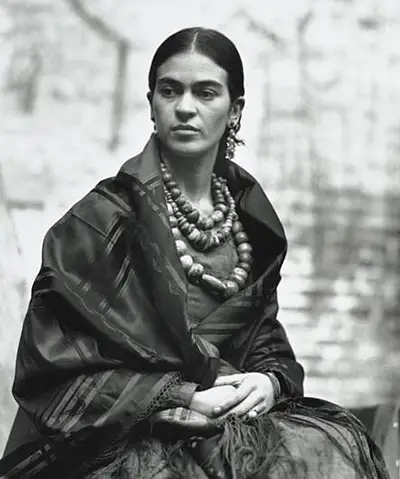
* As an Amazon Associate, and partner with Google Adsense and Ezoic, I earn from qualifying purchases.
Follow the turbulent but inspiring life and career of Mexican artist Frida Kahlo in this extensive biography which focuses on the hardships that drove her artistic career and the relationships which impacted her development as an artist.
Mexican artist Frida Kahlo lived an extraordinary life which remains much celebrated today. Her work ranks amongst the finest of any Mexican artist and the extreme highs and lows of her life are captured in our extensive biography. This famous artist was born on the 6th of July, 1907 in Coyocoan, Mexico City, Mexico and was one of four sisters. Their family home has been labelled the Blue House or Casa Azul.
Frida had an exciting blend of German, Spanish and indigenous Mexican ancestry, coming directly from her parents. This mixed race background created an open minded individual whoses art style was to follow suit. She had a troubled childhood, blighted by illness. Most significantly, she contracted Polio aged 6 which impacted her growth and also left her bed-ridden for half a year. She pursued multiple sports in order to overcome some of these problems and this helped her to at least boost her confidence and become more extrovert, moving into her teens.
Kahlo joined the male-dominated National Preparatory School in Mexico city in 1922 and set about forging a path that would later lead to international stardom. She was immediately outspoken, and her strong character marked her out from the crowd as someone who would likely do something successful, whichever field that may be in. It was around this time that Frida was involved in a serious traffic accident which left her damaged, physically, for the rest of her life. She suffered multiple injuries and required a long period of rehabilitation before she could live a relatively normal life once more.
This serious setback to Kahlo proved to be the catalyst to her new life, as she took up painting for the first time in order to reduce her frustrations at her predicament. It also kept her occupied whilst bed-bound and helped her to recover more quickly. Self-Portrait in a Velvet Dress was her first completed work and set her off on a sequence of artistic introspection which carried on throughout her life. Few artists have held such a dominance in self portraiture as Kahlo, rarely capturing other artistic styles or topics.
Diego Rivera, the famous Mexican muralist, was known to Frida from her school days and they were to re-connect later on as she sought advice on her work. This teacher-pupil relationship was to flourish into a romantic connection which later led to marriage . Frida would then travel frequently in order to accompany Rivera on his work-based trips. These took in San Francisco, New York and Detroit. Whilst clearly possessing some considerable natural talent, artist Kahlo would make use of Rivera's own contacts in order to further her career, both through creative ideas and promotional opportunities. Her travels also brought hew new influences in terms of her own personal style and fashion .
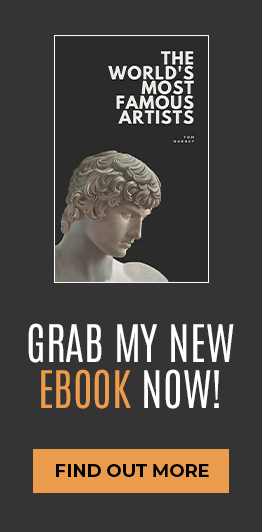
10 Facts About Frida Kahlo
The mexican painter and political activist led a troubled life and left a lasting legacy.
By Google Arts & Culture
Frida Kahlo, June 15, 1919 (1919) by Guillermo Kahlo Museo Frida Kahlo
A young talent
As a child, Magdalena Carmen Frida Kahlo y Calderón filled notebooks with sketches, though she never intended to become an artist. In 1925 at the age of 18, as she was preparing to study at medical school, she was severely injured in a bus accident.
Corset (0) by Frida Kahlo Museo Frida Kahlo
Her pelvis, her spine, her right leg, and shoulder were crushed, and her uterus was pierced by a metal spike. It was a miracle that she survived, but she would never fully recover. For three months after the accident she was confined in bed to a plaster corset.
During this period of recovery, she once again took up art to pass the time. She briefly considered becoming a medical illustrator, but started painting self portraits . Later saying, "I paint myself because I am often alone and I am the subject I know best."
Photograph of Diego and Frida taken by their friend Lucienne when the last panel of the fresco at the New Workers School in New York was finished (3 de diciembre de 1933) by Lucienne Bloch Museo Casa Estudio Diego Rivera y Frida Kahlo
Join the party
In 1927, Kahlo joined the Mexican Communist Party and was introduced to a wide circle of politically-engaged people, such as the photographer Tina Modotti and activist Julio Antonio Mella. At a gathering in June 1928, Kahlo met Diego Rivera . The next year, the two were married.
Weeping Coconuts (Cocos gimientes) (1951) by Frida Kahlo Los Angeles County Museum of Art
A daughter of the revolution
Born in 1910, Kahlo saw herself as a daughter of the Mexican Revolution of the same year, and promoted the revolutionary ideals. She began to emphasise Mexican national identity and anti-colonial practices through her Mestiza dress and peasant-inspired art.
Kahlo combined folk imagery and syles with the Cubist and Surrealist avant-garde across the Atlantic, though she later held the Surrealists in contempt, writing to a friend that they "are so crazy 'intellectual' and rotten that I can't even stand them anymore."
Kahlo and Rivera moved into a new house in the wealthy neighborhood of San Ángel, Mexico City. The building was designed by Le Corbusier 's student Juan O'Gorman . The bohemian residence became an important meeting place for artists and political activists from Mexico and abroad.
Arriving of Leon Trotsky and his wife, Natalia Sedova (1937/1937) by Mayo Brothers Archivo General de la Nación - México
Harbouring the Exiled Trotsky
She and Rivera successfully petitioned the Mexican government to grant asylum to former Soviet leader Leon Trotsky and his wife. The couple lived there from January 1937 until April 1939, with Kahlo and Trotsky not only becoming good friends but also having a brief affair.
Frida painting "Naturaleza viva" (Living Nature) in bed, with Diego at her side (1952) by Juan Guzmán Museo Casa Estudio Diego Rivera y Frida Kahlo
An ongoing struggle
Her bouts of surgery continued into her later years. She suffered from post-operative infections and became bedridden. Yet she continued to paint, using a wheelchair and an adjustable easel. Eventually, she had her right leg amputated.
Frida Kahlo, Juan O’Gorman, and Diego Rivera in the last photograph taken of Frida before her death, at a demonstration against US intervention in Guatemala (2 de julio de 1954) by autor no identificado Museo Casa Estudio Diego Rivera y Frida Kahlo
A fighter to the end
Kahlo continued to campaign even in her final days. On the 2nd of July, 1954, less than two weeks before her death, she joined a protest against the CIA invasion of Guatemala. When she died on the 13th, her body was laid under a communist banner at the Palacio de Bellas Artes .
Today, you can take a tour of La Casa Azul , the family home of Frida Kahlo, and now the Museo Frida Kahlo. Inside, the house remains in almost exactly the same condition as when Kahlo and Rivera lived there, filled with art that shows their admiration for the culture of Mexico.
Appearances Can Be Deceiving
Museo frida kahlo, a tour around the house and studio of diego rivera and frida kahlo, museo casa estudio diego rivera y frida kahlo, reigning men: fashion in menswear, 1715 - 2015, los angeles county museum of art, frida kahlo's teaching contract, archivo general de la nación - méxico, diego rivera's detroit industry, detroit institute of arts, diego rivera and frida kahlo house-studio museum: functionalist architecture, process for making a common bread, ordinary people by extraordinary artists, frida and diego: a smile at halfway, benito juárez's meal two days before his death., self-portrait on the borderline between mexico and the united states, 1932.
ARTS & CULTURE
Frida kahlo.
The Mexican artist’s myriad faces, stranger-than-fiction biography and powerful paintings come to vivid life in a new film
Phyllis Tuchman
/https://tf-cmsv2-smithsonianmag-media.s3.amazonaws.com/filer/9c/04/9c0461e2-407f-48e6-8293-bab6c7c5f353/frida_kahlo_by_guillermo_kahlo.jpg)
Frida Kahlo, who painted mostly small, intensely personal works for herself, family and friends, would likely have been amazed and amused to see what a vast audience her paintings now reach. Today, nearly 50 years after her death, the Mexican artist’s iconic images adorn calendars, greeting cards, posters, pins, even paper dolls. Several years ago the French couturier Jean Paul Gaultier created a collection inspired by Kahlo, and last year a self-portrait she painted in 1933 appeared on a 34-cent U.S. postage stamp. This month, the movie Frida, starring Salma Hayek as the artist and Alfred Molina as her husband, renowned muralist Diego Rivera, opens nationwide. Directed by Julie Taymor, the creative wizard behind Broadway’s long-running hit The Lion King , the film is based on Hayden Herrera’s 1983 biography, Frida. Artfully composed, Taymor’s graphic portrayal remains, for the most part, faithful to the facts of the painter’s life. Although some changes were made because of budget constraints, the movie “is true in spirit,” says Herrera, who was first drawn to Kahlo because of “that thing in her work that commands you—that urgency, that need to communicate.”
Focusing on Kahlo’s creativity and tumultuous love affair with Rivera, the film looks beyond the icon to the human being. “I was completely compelled by her story,” says Taymor. “I knew it superficially; and I admired her paintings but didn’t know them well. When she painted, it was for herself. She transcended her pain. Her paintings are her diary. When you’re doing a movie, you want a story like that.” In the film, the Mexican born and raised Hayek, 36, who was one of the film’s producers, strikes poses from the paintings, which then metamorphose into action-filled scenes. “Once I had the concept of having the paintings come alive,” says Taymor, “I wanted to do it.”
Kahlo, who died July 13, 1954, at the age of 47, reportedly of a pulmonary embolism (though some suspected suicide), has long been recognized as an important artist. In 2001-2002, a major traveling exhibition showcased her work alongside that of Georgia O’Keeffe and Canada’s Emily Carr. Earlier this year several of her paintings were included in a landmark Surrealism show in London and New York. Currently, works by both Kahlo and Rivera are on view through January 5, 2003, at the SeattleArt Museum. As Janet Landay, curator of exhibitions at the Museum of Fine Arts, Houston and one of the organizers of a 1993 exhibition of Kahlo’s work, points out, “Kahlo made personal women’s experiences serious subjects for art, but because of their intense emotional content, her paintings transcend gender boundaries. Intimate and powerful, they demand that viewers—men and women—be moved by them.”
Kahlo produced only about 200 paintings—primarily still lifes and portraits of herself, family and friends. She also kept an illustrated journal and did dozens of drawings. With techniques learned from both her husband and her father, a professional architectural photographer, she created haunting, sensual and stunningly original paintings that fused elements of surrealism, fantasy and folklore into powerful narratives. In contrast to the 20th-century trend toward abstract art, her work was uncompromisingly figurative. Although she received occasional commissions for portraits, she sold relatively few paintings during her lifetime. Today her works fetch astronomical prices at auction. In 2000, a 1929 self-portrait sold for more than $5 million.
Biographies of the artist, which have been translated into many languages, read like the fantastical novels of Gabriel García Márquez as they trace the story of two painters who could not live with or without each other. (Taymor says she views her film version of Kahlo’s life as a “great, great love story.”) Married twice, divorced once and separated countless times, Kahlo and Rivera had numerous affairs, hobnobbed with Communists, capitalists and literati and managed to create some of the most compelling visual images of the 20th century. Filled with such luminaries as writer André Breton, sculptor Isamu Noguchi, playwright Clare Boothe Luce and exiled Russian revolutionary Leon Trotsky, Kahlo’s life played out on a phantasmagorical canvas.
She was born Magdalena Carmen Frida Kahlo y Calderón July 6, 1907, and lived in a house (the Casa Azul, or Blue House, now the Museo Frida Kahlo) built by her father in Coyoacán, then a quiet suburb of Mexico City. The third of her parents’ four daughters, Frida was her father’s favorite—the most intelligent, he thought, and the most like himself. She was a dutiful child but had a fiery temperament. (Shortly before Kahlo and Rivera were wed in 1929, Kahlo’s father warned his future son-in-law, who at age 42 had already had two wives and many mistresses, that Frida, then 21, was “a devil.” Rivera replied: “I know it.”)
A German Jew with deep-set eyes and a bushy mustache, Guillermo Kahlo had immigrated to Mexico in 1891 at the age of 19. After his first wife died in childbirth, he married Matilde Calderón, a Catholic whose ancestry included Indians as well as a Spanish general. Frida portrayed her hybrid ethnicity in a 1936 painting, My Grandparents, My Parents, and I (opposite).
Kahlo adored her father. On a portrait she painted of him in 1951, she inscribed the words, “character generous, intelligent and fine.” Her feelings about her mother were more conflicted. On the one hand, the artist considered her “very nice, active, intelligent.” But she also saw her as fanatically religious, calculating and sometimes even cruel. “She did not know how to read or write,” recalled the artist. “She only knew how to count money.”
A chubby child with a winning smile and sparkling eyes, Kahlo was stricken with polio at the age of 6. After her recovery, her right leg remained thinner than her left and her right foot was stunted. Despite her disabilities or, perhaps, to compensate for them, Kahlo became a tomboy. She played soccer, boxed, wrestled and swam competitively. “My toys were those of a boy: skates, bicycles,” the artist later recalled. (As an adult, she collected dolls.)
Her father taught her photography, including how to retouch and color prints, and one of his friends gave her drawing lessons. In 1922, the 15-year-old Kahlo entered the elite, predominantly male NationalPreparatory School, which was located near the Cathedral in the heart of Mexico City.
As it happened, Rivera was working in the school’s auditorium on his first mural. In his autobiography— My Art, My Life —the artist recalled that he was painting one night high on a scaffold when “all of a sudden the door flew open, and a girl who seemed to be no more than ten or twelve was propelled inside. . . . She had,” he continued, “unusual dignity and self-assurance, and there was a strange fire in her eyes.” Kahlo, who was actually 16, apparently played pranks on the artist. She stole his lunch and soaped the steps by the stage where he was working.
Kahlo planned to become a doctor and took courses in biology, zoology and anatomy. Her knowledge of these disciplines would later add realistic touches to her portraits. She also had a passion for philosophy, which she liked to flaunt. According to biographer Herrera, she would cry out to her boyfriend, Alejandro Gómez Arias, “lend me your Spengler. I don’t have anything to read on the bus.” Her bawdy sense of humor and passion for fun were well known among her circle of friends, many of whom would become leaders of the Mexican left.
Then, on September 17, 1925, the bus on which she and her boyfriend were riding home from school was rammed by a trolley car. A metal handrail broke off and pierced her pelvis. Several people died at the site, and doctors at the hospital where the 18-year-old Kahlo was taken did not think she would survive. Her spine was fractured in three places, her pelvis was crushed and her right leg and foot were severely broken. The first of many operations she would endure over the years brought only temporary relief from pain. “In this hospital,” Kahlo told Gómez Arias, “death dances around my bed at night.” She spent a month in the hospital and was later fitted with a plaster corset, variations of which she would be compelled to wear throughout her life.
Confined to bed for three months, she was unable to return to school. “Without giving it any particular thought,” she recalled, “I started painting.” Kahlo’s mother ordered a portable easel and attached a mirror to the underside of her bed’s canopy so that the nascent artist could be her own model.
Though she knew the works of the old masters only from reproductions, Kahlo had an uncanny ability to incorporate elements of their styles in her work. In a painting she gave to Gómez Arias, for instance, she portrayed herself with a swan neck and tapered fingers, referring to it as “Your Botticeli.”
During her months in bed, she pondered her changed circumstances. To Gómez Arias, she wrote, “Life will reveal [its secrets] to you soon. I already know it all. . . . I was a child who went about in a world of colors. . . . My friends, my companions became women slowly, I became old in instants.”
As she grew stronger, Kahlo began to participate in the politics of the day, which focused on achieving autonomy for the government-run university and a more democratic national government. She joined the Communist party in part because of her friendship with the young Italian photographer Tina Modotti, who had come to Mexico in 1923 with her then companion, photographer Edward Weston. It was most likely at a soiree given by Modotti in late 1928 that Kahlo re-met Rivera.
They were an unlikely pair. The most celebrated artist in Mexico and a dedicated Communist, the charismatic Rivera was more than six feet tall and tipped the scales at 300 pounds. Kahlo, 21 years his junior, weighed 98 pounds and was 5 feet 3 inches tall. He was ungainly and a bit misshapen; she was heart-stoppingly alluring. According to Herrera, Kahlo “started with dramatic material: nearly beautiful, she had slight flaws that increased her magnetism.” Rivera described her “fine nervous body, topped by a delicate face,” and compared her thick eyebrows, which met above her nose, to “the wings of a blackbird, their black arches framing two extraordinary brown eyes.”
Rivera courted Kahlo under the watchful eyes of her parents. Sundays he visited the Casa Azul, ostensibly to critique her paintings. “It was obvious to me,” he later wrote, “that this girl was an authentic artist.” Their friends had reservations about the relationship. One Kahlo pal called Rivera “a pot-bellied, filthy old man.” But Lupe Marín, Rivera’s second wife, marveled at how Kahlo, “this so-called youngster,” drank tequila “like a real mariachi.”
The couple married on August 21, 1929. Kahlo later said her parents described the union as a “marriage between an elephant and a dove.” Kahlo’s 1931 Colonial-style portrait, based on a wedding photograph, captures the contrast. The newlyweds spent almost a year in Cuernavaca while Rivera executed murals commissioned by the American ambassador to Mexico, Dwight Morrow. Kahlo was a devoted wife, bringing Rivera lunch every day, bathing him, cooking for him. Years later Kahlo would paint a naked Rivera resting on her lap as if he were a baby.
With the help of Albert Bender, an American art collector, Rivera obtained a visa to the United States, which previously had been denied him. Since Kahlo had resigned from the Communist party when Rivera, under siege from the Stalinists, was expelled, she was able to accompany him. Like other left-wing Mexican intellectuals, she was now dressing in flamboyant native Mexican costume—embroidered tops and colorful, floor-length skirts, a style associated with the matriarchal society of the region of Tehuantepec. Rivera’s new wife was “a little doll alongside Diego,” Edward Weston wrote in his journal in 1930. “People stop in their tracks to look in wonder.”
The Riveras arrived in the United States in November 1930, settling in San Francisco while Rivera worked on murals for the San Francisco Stock Exchange and the California School of Fine Arts, and Kahlo painted portraits of friends. After a brief stay in New York City for a show of Rivera’s work at the Museum of Modern Art, the couple moved on to Detroit, where Rivera filled the Institute of Arts’ garden court with compelling industrial scenes, and then back to New York City, where he worked on a mural for Rockefeller Center. They stayed in the United States for three years. Diego felt he was living in the future; Frida grew homesick. “I find that Americans completely lack sensibility and good taste,” she observed. “They are boring and they all have faces like unbaked rolls.”
In Manhattan, however, Kahlo was exhilarated by the opportunity to see the works of the old masters firsthand. She also enjoyed going to the movies, especially those starring the Marx Brothers or Laurel and Hardy. And at openings and dinners, she and Rivera met the rich and the renowned.
But for Kahlo, despair and pain were never far away. Before leaving Mexico, she had suffered the first in a series of miscarriages and therapeutic abortions. Due to her trolley-car injuries, she seemed unable to bring a child to term, and every time she lost a baby, she was thrown into a deep depression. Moreover, her polio-afflicted and badly injured right leg and foot often troubled her. While in Michigan, a miscarriage cut another pregnancy short. Then her mother died. Up to that time she had persevered. “I am more or less happy,” she had written to her doctor, “because I have Diego and my mother and my father whom I love so much. I think that is enough. . . . ” Now her world was starting to fall apart.
Kahlo had arrived in America an amateur artist. She had never attended art school, had no studio and had not yet focused on any particular subject matter. “I paint self-portraits because I am so often alone, because I am the person I know best,” she would say years later. Her biographers report that despite her injuries she regularly visited the scaffolding on which Rivera worked in order to bring him lunch and, they speculate, to ward off alluring models. As she watched him paint, she learned the fundamentals of her craft. His imagery recurs in her pictures along with his palette—the sunbaked colors of pre- Columbian art. And from him—though his large-scale wall murals depict historical themes, and her small-scale works relate her autobiography—she learned how to tell a story in paint.
Works from her American period reveal her growing narrative skill. In Self-Portrait on the Borderline betweenMexico and the United States, Kahlo’s homesickness finds expression in an image of herself standing between a pre-Columbian ruin and native flowers on one side and Ford Motor Company smokestacks and looming skyscrapers on the other. In HenryFordHospital, done soon after her miscarriage in Detroit, Kahlo’s signature style starts to emerge. Her desolation and pain are graphically conveyed in this powerful depiction of herself, nude and weeping, on a bloodstained bed. As she would do time and again, she exorcises a devastating experience through the act of painting.
When they returned to Mexico toward the end of 1933, both Kahlo and Rivera were depressed. His RockefellerCenter mural had created a controversy when the owners of the project objected to the heroic portrait of Lenin he had included in it. When Rivera refused to paint out the portrait, the owners had the mural destroyed. (Rivera later re-created a copy for the Palace of Fine Arts in Mexico City.) To a friend Kahlo wrote, Diego “thinks that everything that is happening to him is my fault, because I made him come [back] to Mexico. . . . ” Kahlo herself became physically ill, as she was prone to do in times of stress. Whenever Rivera, a notorious philanderer, became involved with other women, Kahlo succumbed to chronic pain, illness or depression. When he returned home from his wanderings, she would usually recover.
Seeking a fresh start, the Riveras moved into a new home in the upscale San Angel district of Mexico City. The house, now the Diego Rivera Studio museum, featured his-and-her, brightly colored (his was pink, hers, blue) Le Corbusier-like buildings connected by a narrow bridge. Though the plans included a studio for Kahlo, she did little painting, as she was hospitalized three times in 1934. When Rivera began an affair with her younger sister, Cristina, Kahlo moved into an apartment. A few months later, however, after a brief dalliance with the sculptor Isamu Noguchi, Kahlo reconciled with Rivera and returned to San Angel.
In late 1936, Rivera, whose leftist sympathies were more pronounced than ever, interceded with Mexican President Lázaro Cárdenas to have the exiled Leon Trotsky admitted to Mexico. In January 1937, the Russian revolutionary took up a two-year residency with his wife and bodyguards at the Casa Azul, Kahlo’s childhood home, available because Kahlo’s father had moved in with one of her sisters. In a matter of months, Trotsky and Kahlo became lovers. “El viejo” (“the old man”), as she called him, would slip her notes in books. She painted a mesmerizing fulllength portrait of herself (far right), in bourgeois finery, as a gift for the Russian exile. But this liaison, like most of her others, was short lived.
The French Surrealist André Breton and his wife, Jacqueline Lamba, also spent time with the Riveras in San Angel. (Breton would later offer to hold an exhibition of Kahlo’s work in Paris.) Arriving in Mexico in the spring of 1938, they stayed for several months and joined the Riveras and the Trotskys on sight-seeing jaunts. The three couples even considered publishing a book of their conversations. This time, it was Frida and Jacqueline who bonded.
Although Kahlo would claim her art expressed her solitude, she was unusually productive during the time spent with the Trotskys and the Bretons. Her imagery became more varied and her technical skills improved. In the summer of 1938, the actor and art collector Edward G. Robinson visited the Riveras in San Angel and paid $200 each for four of Kahlo’s pictures, among the first she sold. Of Robinson’s purchase she later wrote, “For me it was such a surprise that I marveled and said: ‘This way I am going to be able to be free, I’ll be able to travel and do what I want without asking Diego for money.’”
Shortly after, Kahlo went to New York City for her first one-person show, held at the Julien Levy Gallery, one of the first venues in America to promote Surrealist art. In a brochure for the exhibition, Breton praised Kahlo’s “mixture of candour and insolence.” On the guest list for the opening were artist Georgia O’Keeffe, to whom Kahlo later wrote a fan letter, art historian Meyer Schapiro and Vanity Fair editor Clare Boothe Luce, who commissioned Kahlo to paint a portrait of a friend who had committed suicide. Upset by the graphic nature of Kahlo’s completed painting, however, Luce wanted to destroy it but in the end was persuaded not to. The show was a critical success. Time magazine noted that “the flutter of the week in Manhattan was caused by the first exhibition of paintings by famed muralist Diego Rivera’s . . . wife, Frida Kahlo. . . . Frida’s pictures, mostly painted in oil on copper, had the daintiness of miniatures, the vivid reds and yellows of Mexican tradition, the playfully bloody fancy of an unsentimental child.” A little later, Kahlo’s hand, bedecked with rings, appeared on the cover of Vogue .
Heady with success, Kahlo sailed to France, only to discover that Breton had done nothing about the promised show. A disappointed Kahlo wrote to her latest lover, portrait photographer Nickolas Muray: “It was worthwhile to come here only to see why Europe is rottening, why all this people—good for nothing—are the cause of all the Hitlers and Mussolinis.” Marcel Duchamp— “The only one,” as Kahlo put it, “who has his feet on the earth, among all this bunch of coocoo lunatic sons of bitches of the Surrealists”—saved the day. He got Kahlo her show. The Louvre purchased a self-portrait, its first work by a 20th-century Mexican artist. At the exhibition, according to Rivera, artist Wassily Kandinsky kissed Kahlo’s cheeks “while tears of sheer emotion ran down his face.” Also an admirer, Pablo Picasso gave Kahlo a pair of earrings shaped like hands, which she donned for a later self-portrait. “Neither Derain, nor I, nor you,” Picasso wrote to Rivera, “are capable of painting a head like those of Frida Kahlo.”
Returning to Mexico after six months abroad, Kahlo found Rivera entangled with yet another woman and moved out of their San Angel house and into the Casa Azul. By the end of 1939 the couple had agreed to divorce.
Intent on achieving financial independence, Kahlo painted more intensely than ever before. “To paint is the most terrific thing that there is, but to do it well is very difficult,” she would tell the group of students—known as Los Fridos—to whom she gave instruction in the mid-1940s. “It is necessary . . . to learn the skill very well, to have very strict self-discipline and above all to have love, to feel a great love for painting.” It was during this period that Kahlo created some of her most enduring and distinctive work. In self-portraits, she pictured herself in native Mexican dress with her hair atop her head in traditional braids. Surrounded by pet monkeys, cats and parrots amid exotic vegetation reminiscent of the paintings of Henri Rousseau, she often wore the large pre-Columbian necklaces given to her by Rivera.
In one of only two large canvases ever painted by Kahlo, The Two Fridas, a double self-portrait done at the time of her divorce, one Frida wears a European outfit torn open to reveal a “broken” heart; the other is clad in native Mexican costume. Set against a stormy sky, the “twin sisters,” joined together by a single artery running from one heart to the other, hold hands. Kahlo later wrote that the painting was inspired by her memory of an imaginary childhood friend, but the fact that Rivera himself had been born a twin may also have been a factor in its composition. In another work from this period, Self-Portrait with Cropped Hair (1940), Kahlo, in a man’s suit, holds a pair of scissors she has used to sever the locks that surround the chair on which she sits. More than once when she discovered Rivera with other women, she had cut off the long hair that he adored.
Despite the divorce, Kahlo and Rivera remained connected. When Kahlo’s health deteriorated, Rivera sought medical advice from a mutual friend, San Francisco doctor Leo Eloesser, who felt her problem was “a crisis of nerves.” Eloesser suggested she resolve her relationship with Rivera. “Diego loves you very much,” he wrote, “and you love him. It is also the case, and you know it better than I, that besides you, he has two great loves—1) Painting 2) Women in general. He has never been, nor ever will be, monogamous.” Kahlo apparently recognized the truth of this observation and resigned herself to the situation. In December 1940, the couple remarried in San Francisco.
The reconciliation, however, saw no diminution in tumult. Kahlo continued to fight with her philandering husband and sought out affairs of her own with various men and women, including several of his lovers. Still, Kahlo never tired of setting a beautiful table, cooking elaborate meals (her stepdaughter Guadalupe Rivera filled a cookbook with Kahlo’s recipes) and arranging flowers in her home from her beloved garden. And there were always festive occasions to celebrate. At these meals, recalled Guadalupe, “Frida’s laughter was loud enough to rise above the din of yelling and revolutionary songs.”
During the last decade of her life, Kahlo endured painful operations on her back, her foot and her leg. (In 1953, her right leg had to be amputated below the knee.) She drank heavily—sometimes downing two bottles of cognac a day—and she became addicted to painkillers. As drugs took control of her hands, the surface of her paintings became rough, her brushwork agitated.
In the spring of 1953, Kahlo finally had a one-person show in Mexico City. Her work had previously been seen there only in group shows. Organized by her friend, photographer Lola Alvarez Bravo, the exhibition was held at Alvarez Bravo’s Gallery of Contemporary Art. Though still bedridden following the surgery on her leg, Kahlo did not want to miss the opening night. Arriving by ambulance, she was carried to a canopied bed, which had been transported from her home. The headboard was decorated with pictures of family and friends; papier-mâché skeletons hung from the canopy. Surrounded by admirers, the elaborately costumed Kahlo held court and joined in singing her favorite Mexican ballads.
Kahlo remained a dedicated leftist. Even as her strength ebbed, she painted portraits of Marx and of Stalin and attended demonstrations. Eight days before she died, Kahlo, in a wheelchair and accompanied by Rivera, joined a crowd of 10,000 in Mexico City protesting the overthrow, by the CIA, of the Guatemalan president.
Although much of Kahlo’s life was dominated by her debilitated physical state and emotional turmoil, Taymor’s film focuses on the artist’s inventiveness, delight in beautiful things and playful but caustic sense of humor. Kahlo, too, preferred to emphasize her love of life and a good time. Just days before her death, she incorporated the words Viva La Vida (Long Live Life) into a still life of watermelons. Though some have wondered whether the artist may have intentionally taken her own life, others dismiss the notion. Certainly, she enjoyed life fully and passionately. “It is not worthwhile,” she once said, “to leave this world without having had a little fun in life.”
Get the latest Travel & Culture stories in your inbox.
Art History and Artists
Frida kahlo.

- Occupation: Artist
- Born: July 6, 1907 Mexico City, Mexico
- Died: July 13, 1954 Mexico City, Mexico
- Famous works: Self-Portrait with Thorn Necklace and Hummingbird, The Two Fridas, Memory, the Heart, Henry Ford Hospital
- Style/Period: Surrealism

- Her full name is Magdalena Carmen Frida Kahlo y Calderon.
- In 1984, Mexico declared the works of Frida Kahlo part of the country's national cultural heritage.
- Her painting The Frame was the first painting by a Mexican artist acquired by the Louvre.
- Her paintings often featured aspects of Aztec Mythology and Mexican folklore.
- The major motion picture Frida told the story of her life and earned 6 Academy Award nominations.
- Listen to a recorded reading of this page:
- Read and write
- Reading practice
- Level 3 reading
Frida Kahlo biography

Do you know about Frida Kahlo, the famous Mexican artist? Practise your reading in English with this biography.
Do the preparation exercise first. Then read the text and do the other exercises.
Preparation
Frida kahlo.
Frida Kahlo was a Mexican artist. Her full name was Magdalena Carmen Frida Kahlo y Calderón. She was born in Coyoacán, near Mexico City, in 1907. Frida grew up in a bright blue house called La Casa Azul with her parents and sisters. When she was six years old she became ill with polio and her leg was permanently damaged.
Starting to paint
Frida spent a lot of her life in and out of hospitals. She had many health problems and she suffered a lot of pain. When she was eighteen, she was in a bus accident. She broke lots of bones and she spent many months recovering. It was at this time that Frida started to paint. Many of her paintings from this time are self-portraits that show her pain and suffering.
Married life and career
In 1929 Frida married Diego Rivera, a Mexican artist who was famous for painting huge murals on walls. Both artists continued their work and became successful at home and abroad. After they got married, Frida started to wear traditional Mexican clothes and became interested in Mexican folk art. This influenced her paintings, which are very bright and colourful, with an original style that is very personal to Frida. However, they continued to show the pain and sadness which she experienced during her life.
Death and legacy
Frida Kahlo died on 13 July 1954, after suffering more and more health problems. Her husband died three years later. Today Frida and Diego's home, La Casa Azul, is a very popular museum, dedicated to Frida's life and work. It displays paintings by Frida and Diego, as well as many objects from their life, to help tell the story of one of the most important artists in the twentieth century.
Who are your favourite artists? Tell us about them!
- Log in or register to post comments
English courses for children aged 6-17
Sign up to our newsletter for free learning tips and resources
We will process your data to send you our newsletter and updates based on your consent. You can unsubscribe at any time by clicking the "unsubscribe" link at the bottom of every email. Read our privacy policy for more information.
- Skip to main content
- Keyboard shortcuts for audio player
Frida Kahlo, in her own words: A new documentary draws from diaries, letters

Mandalit del Barco

A new documentary about Frida Kahlo's life, now streaming on Amazon Prime, tells her story using her own words and art. Leo Matiz/Fundación Leo Matiz hide caption
A new documentary about Frida Kahlo's life, now streaming on Amazon Prime, tells her story using her own words and art.
"I paint myself because that's who I know the best," the late Mexican artist Frida Kahlo once wrote in her illustrated diary. So it's fitting that a new documentary about Kahlo's life, now streaming on Amazon Prime, tells her story using her own words and art.
In the 70 years since Kahlo's death there have been countless efforts to revisit her complicated life, politics and artwork. Most famous is probably the 2002 fictional film starring Salma Hayek and directed by Julie Taymor that depicted Kahlo's tempestuous relationship with painter Diego Rivera. Many of these treatments have relied on actors, interviews with academics, art historians and contemporary artists. Filmmaker Carla Gutiérrez wanted a fresh take.
"Instead of having that historical distance of other people explaining [to] us what she meant with her art," Gutiérrez says, "I really wanted to give that gift to viewers of just hearing from her own words. We wanted to have the most intimate entry way into her heart and into her mind."

In Frida, Kahlo's words are taken from letters and diaries, and voiced by Mexican actor Fernanda Echevarría del Rivero. The film is in Spanish, with English subtitles. Archivo Manuel Álvarez Bravo, S.C. hide caption
In Frida, Kahlo's words are taken from letters and diaries, and voiced by Mexican actor Fernanda Echevarría del Rivero. The film is in Spanish, with English subtitles.
In Gutiérrez's documentary Frida, Kahlo's words are taken from handwritten letters and illustrated diaries, and voiced by Mexican actor Fernanda Echevarría del Rivero. The film is in Spanish, with English subtitles.
Gutiérrez says she wanted to get inside Kahlo's head. "What was she thinking? what was she feeling? I felt that as a Latina, somebody that grew up in Latin America, there was this connection I have with the world that created Frida."
Gutiérrez was born in Peru and saw her first Frida Kahlo painting, as a college student in Massachusetts. It was an image of Kahlo standing with one foot in Mexico, another in the U.S. "Her impressions of the United States and yearning [for] home for Mexico, that painting really reflected my own experience," says Gutiérrez. "And then I became obsessed, like millions of people around the world."
As an editor, Gutiérrez has worked on documentaries on other what she calls "badass women", including the late Supreme Court Justice Ruth Bader Ginsberg , singer Chavela Vargas and chef Julia Child . But Frida is her first film as director.

The Picture Show
Frida kahlo's private stash of pictures.
She enlisted the help of Hayden Herrera, who wrote the definitive Frida Kahlo biography in 1983 . Gutiérrez' team combed through Herrera's closets and attic, looking through her archives.
"We had a good time," Herrera says. "I basically gave them all my research material."
That included transcripts of interviews with people who knew Kahlo. One of the film's archivists, Gabriel Rivera, also scoured university libraries, museums and private collections finding photos and handwritten messages.
"These letters often have little doodles on them," Rivera says. "She would, like, do kind of lipstick kisses on these letters."
The film includes the words written by or about Kahlo's contemporaries, including Diego Rivera, who she married twice, her friends such as surrealist André Breton and her lovers such as Russian revolutionary leader Leon Trotsky.

Some of Kahlo's paintings are slightly animated in the new film. Archivo Manuel Álvarez Bravo, S.C. hide caption
Some of Kahlo's paintings are slightly animated in the new film.
Gabriel Rivera says they tried to follow any lead, including a tip about some footage of Kahlo dancing in the streets of New York City with a rose stem gripped in her mouth. He discovered through writings that the film canister had been left on an airplane in the late 1960s, which Rivera said is "just devastating." They tried to find lost luggage and are still hoping it shows up one day.
But there is plenty of material they did find.
In Mexico, another archivist, Adrián Gutiérrez, was able to collect some rarely seen photos and footage of Kahlo and Rivera together, and of Rivera kissing another woman. There's footage of the Mexican revolutionary Emilio Zapata and of Red Cross workers in Mexico City bandaging trolley accident victims like Kahlo, who was famously injured as a teen. She painted about that and other pain she suffered.
For the documentary, composer Víctor Hernández Stumpfhauser created a soundtrack of electronic music with folkloric guitar and the ethereal voice of his wife, Alexa Ramírez.
Hear Mandalit del Barco's 1991 radio documentary about Frida Kahlo
"The idea was that Frida herself was so ahead of her time, with her thoughts, her ideas. She was a very modern person," says Stumpfhauser. "So we thought, well, let's let's do something modern, but of course, with a with a Mexican flair."
Gutiérrez also made the decision to slightly animate some of Kahlo's paintings. Frida's open heart beats and bleeds, tears roll down her face, and when she cuts her hair in desperation over her divorce, her scissors move and pieces of her hair fall to the floor.

Latin America
As mexico capitalizes on her image, has frida kahlo become over-commercialized.
The Salma Hayek film also animated some of Kahlo's work. But Herrera says doing so in a documentary was gutsy.
"When I saw the first animation, I thought, Oh my God," says Herrera. "But then I found it really seductive and really added so much to the understanding of her paintings. I found them very astute and actually quite witty. And they brought you closer to Frida."

Art Where You're At
5 lesser-known, late-in-life works by frida kahlo now on view in dallas.
Herrera says its remarkable that Frida mania is still very much alive.
"I think she would have been pleased that we're still talking about her, and I think she would have liked this film," she says. "Although seeing your own paintings animated might not be easy, but she might have given one of her big guffaws and laughed and thought it was amusing."
Herrera says this latest documentary is her favorite telling of Frida Kahlo, and is itself a work of art.

Detroit's 'Frida' Aims To Build Latino Audiences For Opera

Music Interviews
The villalobos brothers match music with frida kahlo.
- frida kahlo
- A short biography
- Frida Kahlo cult
- Frida icon of the cyborg
- Frida's disturbing art
- Obsession of self-portraits
- Renate Reichert
- Dance, Musical, Opera
- Illustration books
- Tina Modotti
- Yasumasa Morimura
- Patrice van Ramshorst
- Frida and food
- Galleria foto
- Video Gallery
- News Archive
- Exhibitions
- Permanent Exhibitions
- Bio & Frida cult
Frida Kahlo's life in brief
Frida Kahlo was born on July 6, 1907 in the house of her parents, known as La Casa Azul (The Blue House), in Coyoacan. Frida always claimed to be born on 1910, the year of the outbreak of the Mexican revolution, so that people could directly associate her with the modern Mexico. This detail well introduces us to a singular personality, characterized since her childhood by a deep sense of independence and rebellion against ordinary social and moral habits, moved by passion and sensuality, proud of her "Mexicanidad" and cultural tradition set against the reigning Americanization: everything mixed with a peculiar sense of humour. Her life was marked by physical suffering, started with the polio contracted at the age of five and worsen by her life-dominating event occurred in 1925. A bus accident caused severe injuries to her body owing to a pole that pierced her from the stomach to the pelvis. The medicine of her time tortured her body with surgical operations (32 throughout her life), corsets of different kinds and mechanical "stretching" systems. Lots of her works were painted laying in the bed. Drawing on personal experiences, her miscarriages, and her numerous operations, Kahlo's works are often characterized by portrayals of pain. Of her 143 paintings, 55 are self-portraits which often incorporate symbolic portrayals of physical and psychological wounds. As a young artist, Kahlo approached the famous Mexican painter, Diego Rivera, who recognized her talent and her unique expression as truly special and uniquely Mexican. He encouraged her development as an artist and soon began an intimate relationship with Frida. They were married in 1929, despite the disapproval of Frida's mother, divorced and then remarried in 1940.
Their union was not an usual one ... Diego's several affairs, including one with Frida's sister Cristina, upset her. In response to this betrayal from her family, Kahlo shaved off the majority of her signature long dark hair.
On the other hand, she had also a lot of lovers, men and women, such as Leon Trotsky and André Breton's wife....
She was desperate to have a child and was heartbroken when she experienced a second miscarriage in 1934. Indeed she had several miscarriages and at least three therapeutic abortions throughout her life.
In 1930, Frida and Diego lived in San Francisco, California. Then they moved to New York City for Rivera's artwork show at the Museum of Modern Art. They stayed olso in Detroit while Diego Rivera worked for Detroit Institute of Arts. In 1933 the couple had to move back to Mexico when Rivera tried to include the communist leader Vladimir Lenin in a mural commissioned by Nelson Rockfeller at the Rockfeller Center.
In 1938, Frida Kahlo became a friend of André Breton, one of the major figures of the Surrealism movement. Frida said she never considered herself as a Surrealist "until André Breton came to Mexico and told me I was one".
In the same year, she had an exhibition at a New York City gallery. She sold about half of the 25 paintings shown there and received two commissions.
At the invitation of André Breton, she went to France in 1939 and was featured at an exhibition of her paintings in Paris. The Louvre bought one of her paintings, The Frame, which was displayed at the exhibit. This was the first work by a 20th century Mexican artist ever purchased by the internationally renowned museum. She also developed friendships with such artists as Marcel Duchamp, March Chagall and Pablo Picasso.
In 1941, the Mexican government commissioned Kahlo to paint five portraits of famous Mexican women, but she was unable to complete the job. That year, she lost her loving father and continued to struggle with chronic health issues. Despite her personal difficulties, her work grew in popularity and was featured in a number of group shows at this time. Kahlo had her first solo exhibition in Mexico in 1953. Kahlo attended the inauguration of the show despite being bedridden at the time. Kahlo arrived by ambulance and spent the evening in a four-poster bed built up in the gallery exclusively for her, talking and rejoicing with the event's participants.
A few days before her death on July 13, 1954, Frida wrote in her diary: "I hope the exit is joyful - and I hope never to return - Frida". The official cause of death was given as pulmonary embolism, although some suspected that she died from overdose that may or may not have been accidental.
See my Inspirations section for:
- complete and updated info about works dedicated to Frida in several artistic fields: Movies (Films, documentaries, biopics) Theater Dance Poetry
- pages dedicated to selected artists inspired by her life and her art : Yasumasa Murimura Renate Reichert Patrice van Ramshorst
- a special page about the relationship between Frida and the Italian photographer Tina Modotti
Articles about Frida's cult and Fridamania available in this section .
Among her numerous biographies I strongly suggest " FRIDA. A Biography of Frida Kahlo " by Hayden Herrera.
video by RAI ARTE (in Italian)
Italian article by Finestre sull'Arte
Visit the site
Back to Top
www.fridakahlo.it
Edited and written by Daniela Falini
Frida Kahlo’s story has been told and retold. A new doc captures the voice of the Mexican painter
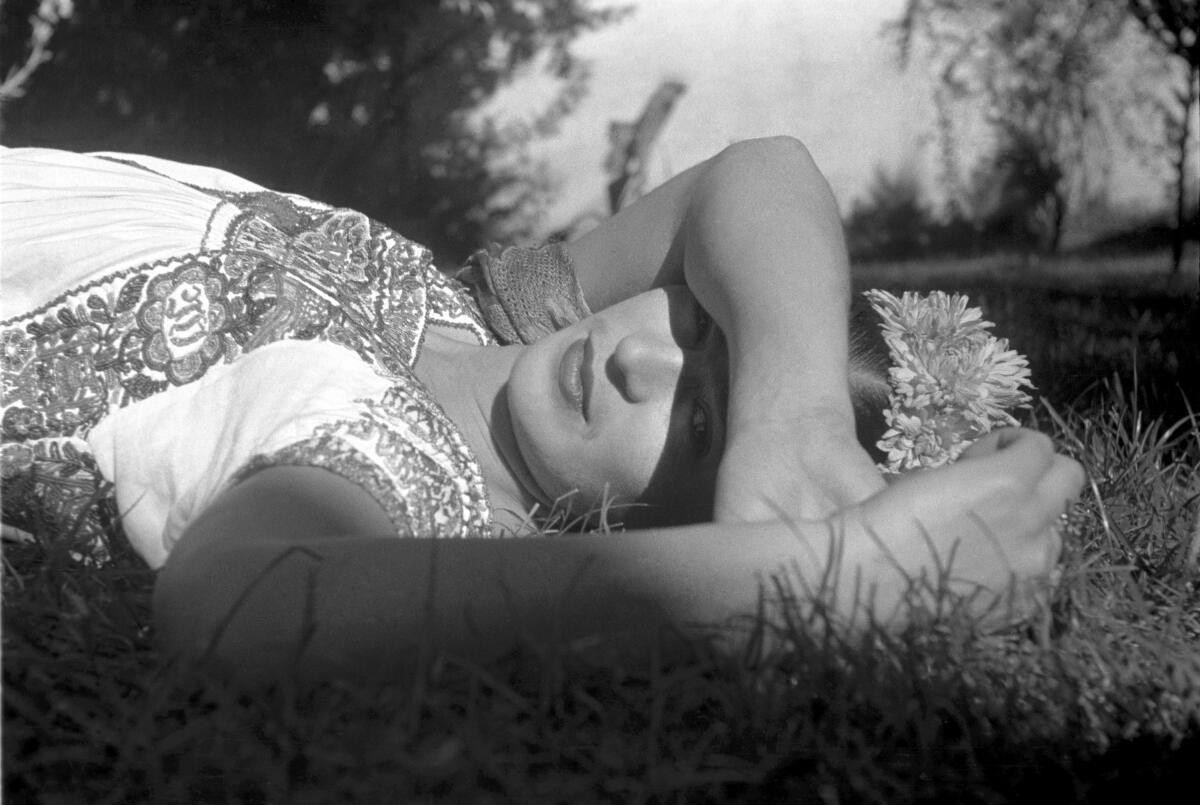
- Show more sharing options
- Copy Link URL Copied!
It’s the weekend and I’m dreaming about sushi from Waka Sakura in Gardena. I’m Carolina A. Miranda , art and design columnist at the Los Angeles Times, with all the raw fish and essential arts news:
A new take on Frida
Is it possible to know any more about Frida Kahlo than we already do? The 20th century Mexican painter placed her tumultuous life and her bodily pains on her canvases. Her husband, muralist Diego Rivera , incorporated her visage into some of his most famous murals . She was photographed relentlessly, even appearing in Vogue . And that was just in her lifetime. (Kahlo died in 1954 at the age of 47.)
Since then, she has been depicted in feature films by Mexican actors Ofelia Medina and Salma Hayek (in 1983 and 2002 , respectively), as well as in documentaries — most recently in director Louise Lockwood’s three-part series “Becoming Frida Kahlo.” She is also the subject of countless murals and other art. In Mexico City in 2016, I saw a fascinating installation by artist Juan Acha at the Museo de Arte Moderno that examined the ways in which Kahlo’s 1939 canvas “Las Dos Fridas” has been copied by fellow artists and appropriated by popular culture.
Kahlo’s work and her image also have generated endless mountains of merch (also addressed in Acha’s installation). Currently sitting on my desk is a stack of Frida Kahlo-branded cosmetics I acquired at Walgreens several years ago — objects in search of an essay.
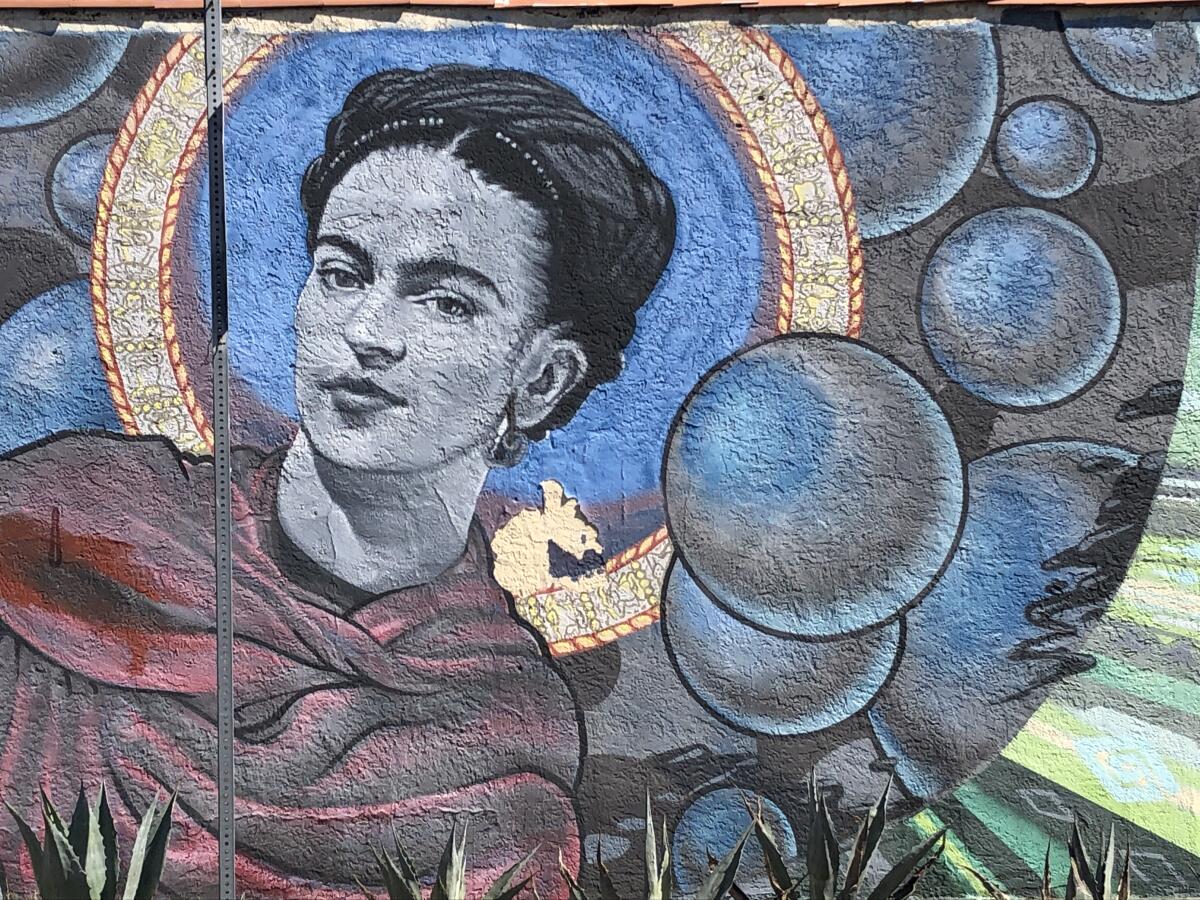
All of this means that Peruvian-born director Carla Gutiérrez’s new documentary, “Frida , ” which landed this week on Prime Video , is entering a crowded field. Clocking in at almost 90 minutes, the doc provides a cursory overview of this well-chronicled artist. Certainly, the story of Kahlo could fill a set of encyclopedias: She came of age in the wake of the Mexican Revolution , was inspired by its mission to rethink the essence of Mexican culture, counted Isamu Noguchi and Leon Trotsky among her lovers and produced groundbreaking paintings, inspired by folk traditions, that depict the devastations of womanhood. ( Hayden Herrera’s famous biography is more than 500 pages long.)
Like many Kahlo projects, Gutiérrez’s storyline rests on the broad narrative arc of Kahlo’s life. (If you’ve read Herrera’s biography, you’re probably not going to learn much.) But the film manages to stand out on a few fronts. For one, there are no awkward reenactments and no talking heads. Visuals consist exclusively of a mix of vintage footage and photography, along with Kahlo’s diaristic drawings and paintings — some of which are animated for added effect. Animating a painting can be cloying. (Can we let painting be painting?) But the filmmaker approaches her work with reverence. And the structure of the narrative, which centers Kahlo’s voice, drawn from her letters and diaries, makes the enterprise worthwhile.

Often translations of Kahlo’s writings soften her language. But “Frida” lets Kahlo be Kahlo. She calls Rivera “la gran caca ” (the big s—) and describes wanting to be “f—” by a school crush. She trash-talks the French Surrealists and expresses profound disgust with the Depression-era United States. “I am completely disappointed with the famous United States,” she declares. “Everything here is about appearances, but deep down it’s truly s—. I’ve seen thousands of people in the most terrible conditions, without anything to eat or anywhere to sleep.”
The narration, wonderfully performed by Fernanda Echevarría del Rivero , captures the musicality of Mexican Spanish — as well as Kahlo’s irreverent personality. It’s a nice break from the often-depicted long-suffering martyr.
You’re reading Essential Arts.
Carolina A. Miranda guides you through the depth and breadth of Southern California’s complex cultural sphere.
You may occasionally receive promotional content from the Los Angeles Times.
If you’re dipping a toe into the world of Kahlo, “Frida” is a good introductory work. But if you want something deeper, I recommend turning to Lockwood’s docuseries “Becoming Frida Kahlo,” which aired on PBS last fall.
The documentary tracks down key players: biographer Herrera, along with historians Martha Zamora and Luis-Martín Lozano , Kahlo’s great-niece Cristina Kahlo and Rivera’s grandson Juan Coronel Rivera . In addition to Kahlo’s life, the series explores the artist’s influences, which include the politics of the era, as well as important female artists such as photographer Tina Modotti . (If you want to keep going down the rabbit hole, British film theorists Laura Mulvey and Peter Wollen made an interesting, impressionistic short film in 1983 that compared the work of Kahlo and Modotti — including their interest in the matriarchal societies of Tehuantepec .)
But altogether, these documentaries show that there is always room for more — namely, a deeper exploration of Kahlo’s art, its roots and its resonances. Kahlo makes for an absorbing narrative, but just as fascinating is the social and political context that produced her — including complex racial politics that mythologized Indigeneity while also subsuming it to a broader mestizo culture . Kahlo’s story has been told and retold, but there are still pieces left to divulge.
“Frida” is now screening on Prime Video .
Musical chairs
There are so many big personnel moves in the world of fine arts this week, it’s hard to keep up with them all!
Here in SoCal, L.A. Opera announced that music director James Conlon will step down after the 2025-26 season. “I have a lot of energy left, a lot of passion left,” Conlon tells The Times’ Jessica Gelt . “And there are other things that I feel I have wanted to do and I just can’t.” His departure will coincide with that of the L . A . Phil’s Gustavo Dudamel — marking a sea change for classical music in the city.

In the Bay Area, the big news is that Esa-Pekka Salonen is stepping down as music director of the San Francisco Symphony in 2025. In a statement to KQED , Salonen said he was leaving because “I do not share the same goals for the future of the institution as the Board of Governors.”
Joshua Kosman , classical music critic at the San Francisco Chronicle , theorizes that the COVID-19 pandemic put a dent in Salonen’s plans for the orchestra — turning what should have been a time of reinvention into one of survival — and he nods to the conductor’s tensions with the board. “Yet in spite of everything,” he writes , “the Salonen years have been a glorious time for Symphony audiences, full of musical adventure, discovery and luxurious execution.”
Meanwhile on the Right Coast...
Roberta Smith , the venerable co-chief art critic at the New York Times , has announced her retirement after 32 years at the paper. Over her tenure, she authored some 4,500 reviews and essays and was the first woman to hold the title of chief art critic. “In my coals-to-Newcastle-life,” Smith stated in an Instagram post , “I will have more time to pursue my number one interest, which is going to galleries and museums, looking at stuff.” Hyperallergic’s Valentina Di Liscia spotlights some of her career highlights .
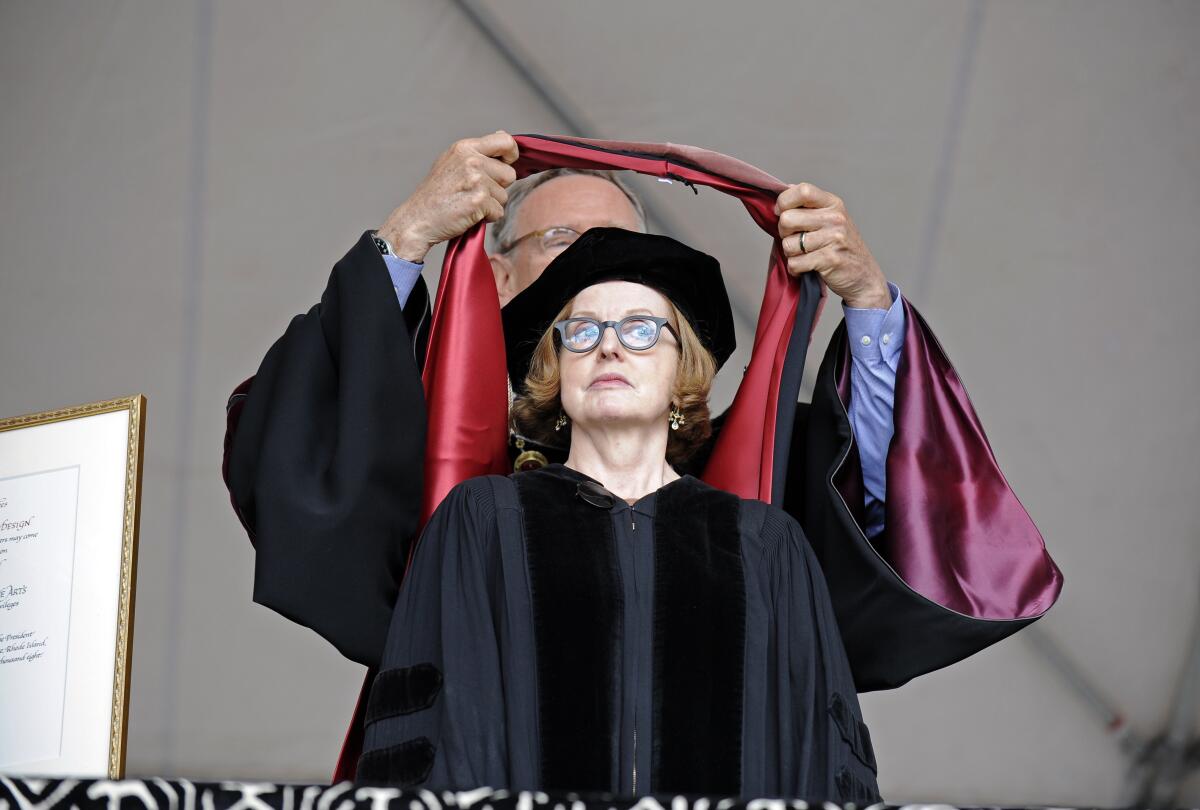
Tina Rivers Ryan , a curator who specialized in digital art at the Buffalo AKG Art Museum , was named the top editor at Artforum . This follows a period of turmoil after editor in chief David Velasco was fired for publishing an open letter in support of the Palestinian cause.
Performing arts
Times theater critic Charles McNulty writes that there are few plays more appropriate for our pandemic age than Henrik Ibsen’s “An Enemy of the People.” Written in 1882, the story about a doctor-turned-whistleblower has been surfacing a lot as of late. It was recently reimagined by Theater of War Productions and Amy Herzog has written her own adaptation, which will soon premiere on Broadway. “The central conflict of ‘An Enemy of the People’ resonates in manifold ways today,” writes McNulty, “from the water crisis in Flint, Mich., to the political demonization of public health experts during the COVID-19 pandemic to the MAGA Republican effort to undermine truth itself.”
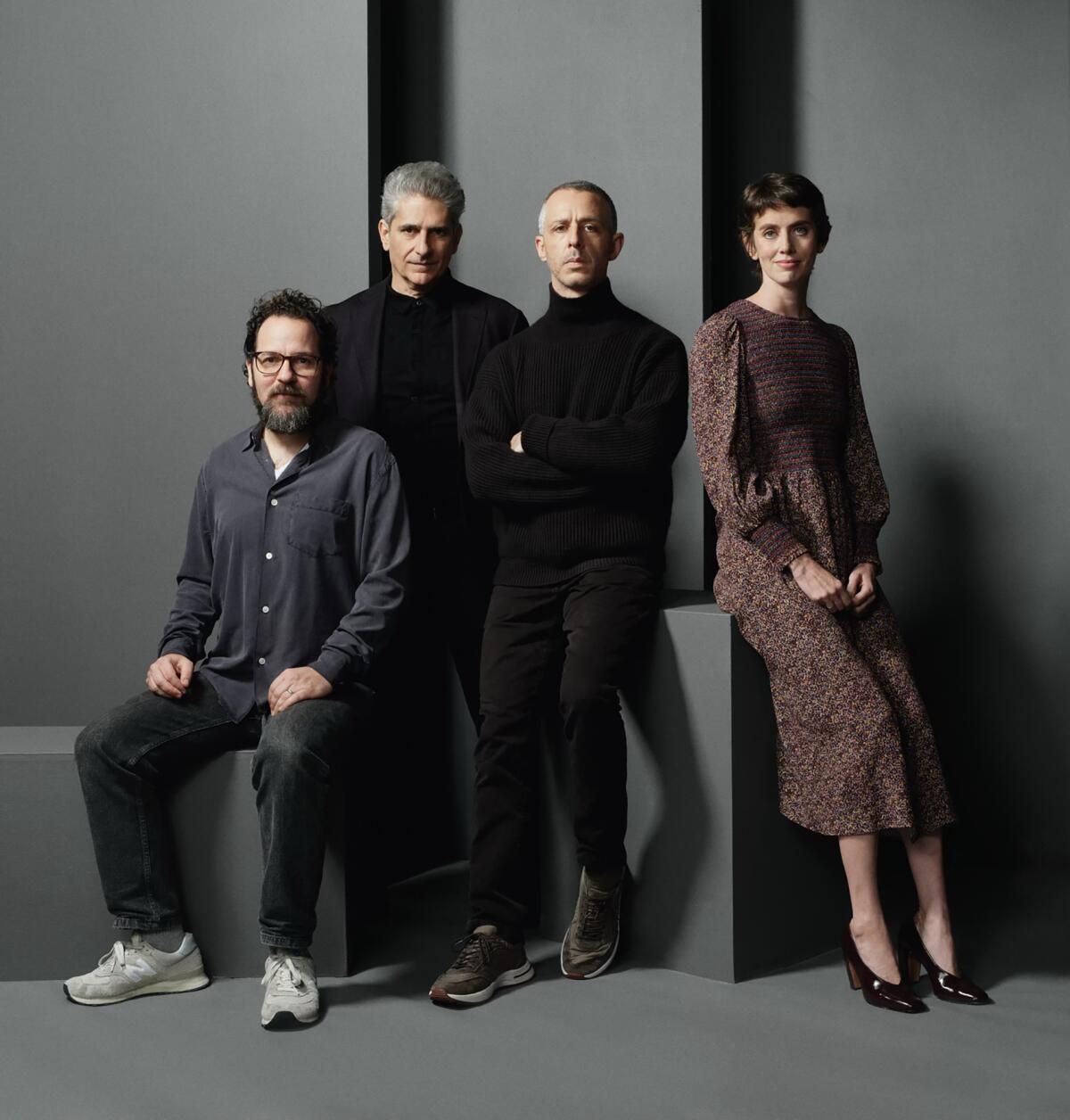
“The Last Repair Shop” is a remarkable, inspiring doc about the craftspeople who maintain the musical instruments for LAUSD — and on Sunday it won the Academy Award for documentary short . This marks the first-ever Oscar win for The Times, which produced the film. (!!!) Jazz critic Nate Chinen , who writes “The Gig,” has a great piece on the doc — and what it represents for co-director Kris Bowers , a jazz pianist and composer.
Do not miss this gorgeous little film. Watch “The Last Repair Shop” here .
In and out of the galleries
In 2020, Elizabeth Alexander launched the Monuments Project at the Mellon Foundation to help preserve and recontextualize monuments — as well as remove them when communities no longer deem them appropriate. This has resulted not just in a shift in the histories honored, but in what is considered a monument to begin with . “There are so many ways we mark spaces to tell stories,” says Alexander. A monument could be a boulder. It could also be a book.

Speaking of monuments, this story about clashes over an anti-abortion monument in Arkansas is all kinds of bananas .
Jori Finkel has an interesting article in the Art Newspaper about a new show of Jean-Michel Basquiat’s work at Gagosian that focuses on the years that the artist spent in L.A.
Have you seen mysterious images of pink sheep around Los Angeles? Over on De Los , reporter Steven Vargas profiles artist Ricky Sencion — a.k.a. Little Ricky — who was inspired to paste them around the city after reading a quote by designer Alexander McQueen .
Design time
My colleague Lisa Boone looks into the latest in ADU design : a tight, 300-square-foot unit , tucked above a garage, by architects Jefferson Schierbeek and Su Addison , that make the most of smart storage areas, high ceilings and strategically placed windows.
Enjoying this newsletter? Consider subscribing to the Los Angeles Times
Your support helps us deliver the news that matters most. Become a subscriber.
A building by architect Samuel Tilden Norton , designer of the Wilshire Boulevard Temple , is under threat of demolition. This week, the L.A. City Council voted to allow the destruction of the B’nai B’rith Lodge , completed in 1924, a Jewish landmark that later became an important organizing center for various labor unions. Preservationists and community advocates are urging Catholic Charities , which now owns the building, to repair and reuse it. The Times’ Angie Orellana Hernandez has the details .

Student art on the Vegas Sphere ? The entity that manages the Sphere has announced a design competition for students of the Clark County School District and the University of Nevada, Las Vegas .
In more Esa-Pekka Salonen news, the San Francisco Symphony music director has won the Polar Music Prize .
Barry Hughson , of the National Ballet of Canada, is the new executive director of American Ballet Theater in New York.
Elizabeth C. Babcock has been named the inaugural director of the Smithsonian American Women’s History Museum in Washington, D.C. She is currently the CEO and president of Forever Balboa Park in San Diego.
Dalila Scruggs has joined the Smithsonian American Art Museum as the museum’s first curator of African American art .
Edward Bond , a British playwright known for unsparing work depicting rage and violence, whose 1965 play “Saved” led to the end of British theatrical censorship, has died at 89 .
Lynn Fainchtein , who served as music supervisor on important Mexican films such as Alejandro González Iñárritu’s “Amores Perros” and Alfonso Cuaron’s “Roma,” is dead at 61 .
In the news
— I’m very into photographer Fujio Kito’s Tumblr of Japanese playgrounds at night. — I’m also into this episode of the “Critics at Large” podcast about fictions set in the workplace. I’d add Netflix’s darkly hilarious “Carol & the End of the World” to their list, which is all about using office mundanity to while away time until an inevitable apocalypse . — Edward Zitron has an interesting essay on AI and the “Habsburg” internet, where originality goes to die . — A new study of Indigenous cave art in Puerto Rico shows that it is much older than previously thought . — Pablo Helguera has a rather comical dispatch on a conservation effort gone slightly wrong at Mexico City’s Metropolitan Cathedral . — A work by L.A. artist Charles Gaines featuring Palestinian scholar Edward Said was deinstalled then reinstalled at the ICA Miami , but it is unclear why . — Workers at the Metropolitan Museum of Art have delivered a letter to museum leaders to address the destruction of cultural heritage sites in Gaza . — Dancer and choreographer Carlos Acosta is reimagining “The Nutcracker” with a Cuban theme . — Every IKEA catalog since 1950 .
And last but not least ...
The best Kate Middleton Photoshop memes .
The biggest entertainment stories
Get our big stories about Hollywood, film, television, music, arts, culture and more right in your inbox as soon as they publish.

Carolina A. Miranda is a former Los Angeles Times columnist who focused on art and design, with regular forays into other areas of culture, including performance, books and digital life.
More From the Los Angeles Times

Company Town
Chuck Todd bashes NBC News hiring of former RNC chief Ronna McDaniel
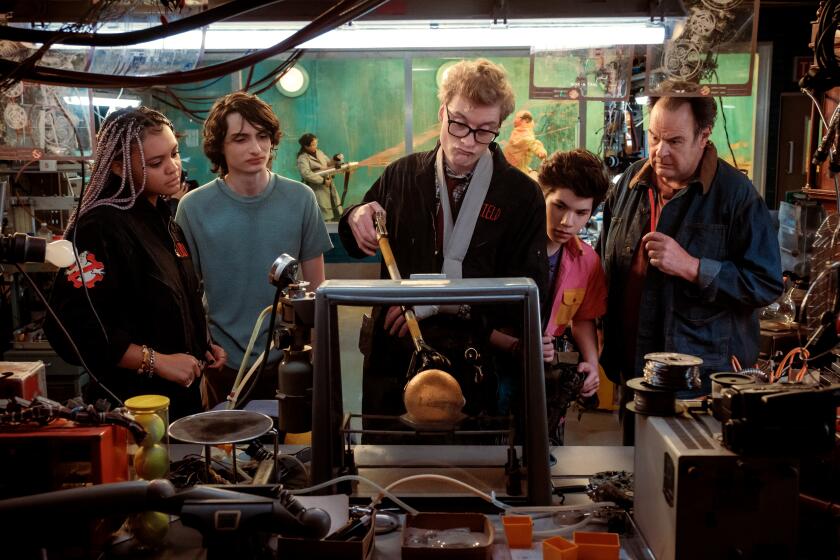
‘Ghostbusters: Frozen Empire’ collects a cool $45.2 million at weekend box office
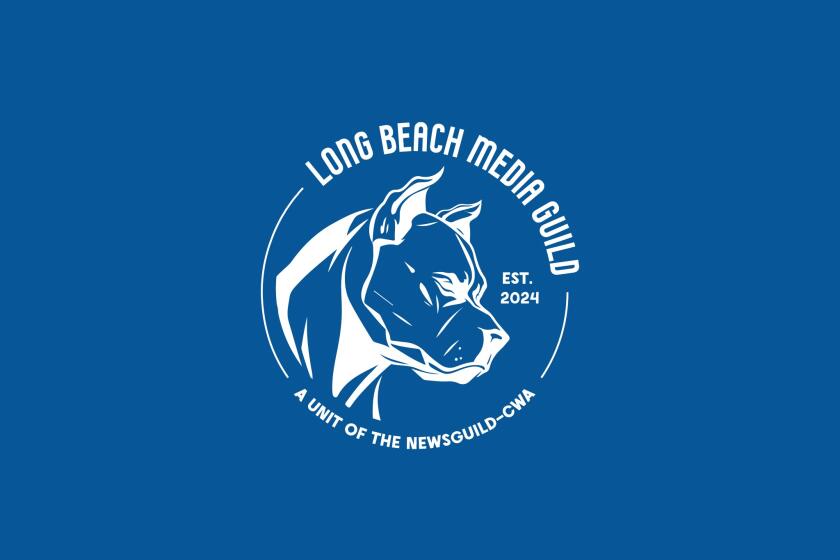
Long Beach Post staffers laid off after moving to unionize and going on strike
March 22, 2024
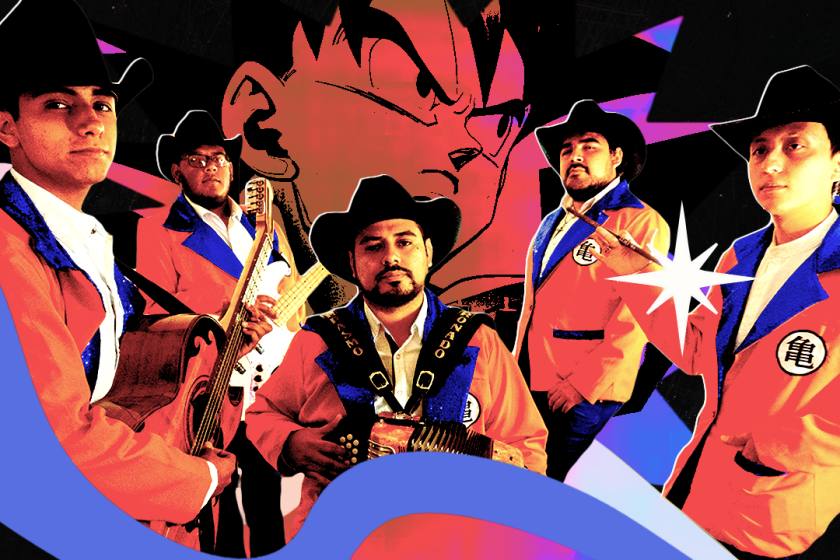
Meet Los Shinigamis del Norte, a band that fuses a love of anime with norteño
A new film tells Frida Kahlo's story in her own words for the first time
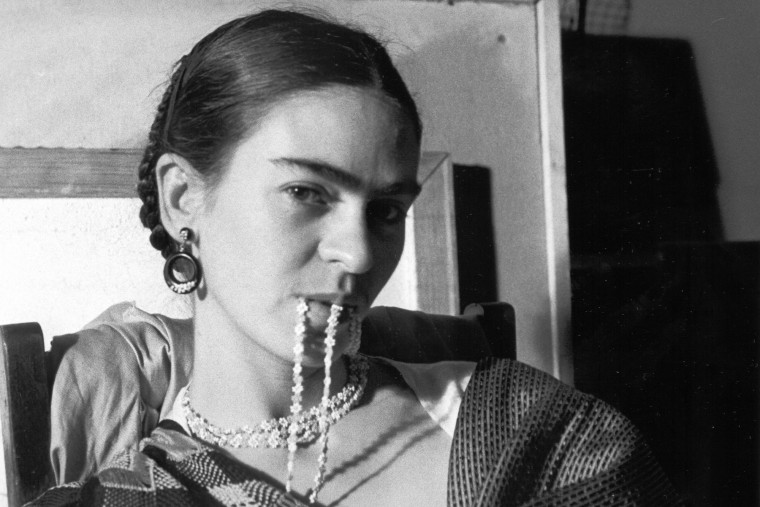
Frida Kahlo's distinct image and iconic paintings are omnipresent art symbols recognizable by most people even 70 years after her death, creating a false sense that everything there is to say about the Mexican painter has already been said.
But filmmaker Carla Gutiérrez cuts through that by doing what no one has done before in retelling the legendary artist’s story on-screen: use Kahlo's own words.
In her new documentary film "Frida," Gutiérrez uses the painter’s illustrated diary , intimate correspondence and candid print interviews to verbalize the artist’s innermost thoughts. Those emotions beautifully come to life through the lyrical animation of Kahlo's unforgettable artwork.
The combination of these elements in Gutiérrez’s feature film directorial debut results in a refreshing narrative that is as introspective as Kahlo’s paintings, most of which are self-portraits.
“I really felt that there was an intimacy that we could capture with our film and bring her in a different way to viewers,” Gutiérrez told NBC News. “For us, it was about always capturing the essence of Frida and her spirit.”
In the film, the earnest delivery of voiceover actor Fernanda Echevarría del Rivero as Kahlo allows the audience to feel an even bigger affinity to the artist, as if she was the one telling us her deepest secrets from her childhood and her adulthood.”
Kahlo’s voice has remained a mystery for years. There is one recording believed to contain the sound and tone of the artist’s voice , according to Mexico’s Fonoteca Nacional, which archives old radio shows and other kinds of recordings. The Kahlo Family has denied this, saying that as far as they know, " there are no records of Frida’s voice ."
The voiceovers in "Frida" are effectively used to deliver poignant revelations about Kahlo and her life. At times, they are so personal, it almost feels like we should not be listening to them.
In her letters and diary, Kahlo wrote about the ups and downs of her relationship and marriage to acclaimed muralist Diego Rivera, her romance with the Russian revolutionary Leon Trotsky, and some of her first memories questioning the Catholic faith, as well as gender roles.
Viewers also get to go inside Kahlo's mind as she recovered from a life-threatening accident that left her with fractures in her spine, leg, collarbone and pelvis — injures that resulted in multiple miscarriages and dozens of surgical procedures later in her life.
"There is a way of approaching biographies where you just list all the things that happen in somebody's life. But for me, it's really more important to capture the spirit of somebody and the emotional journey of that person," Gutiérrez said.
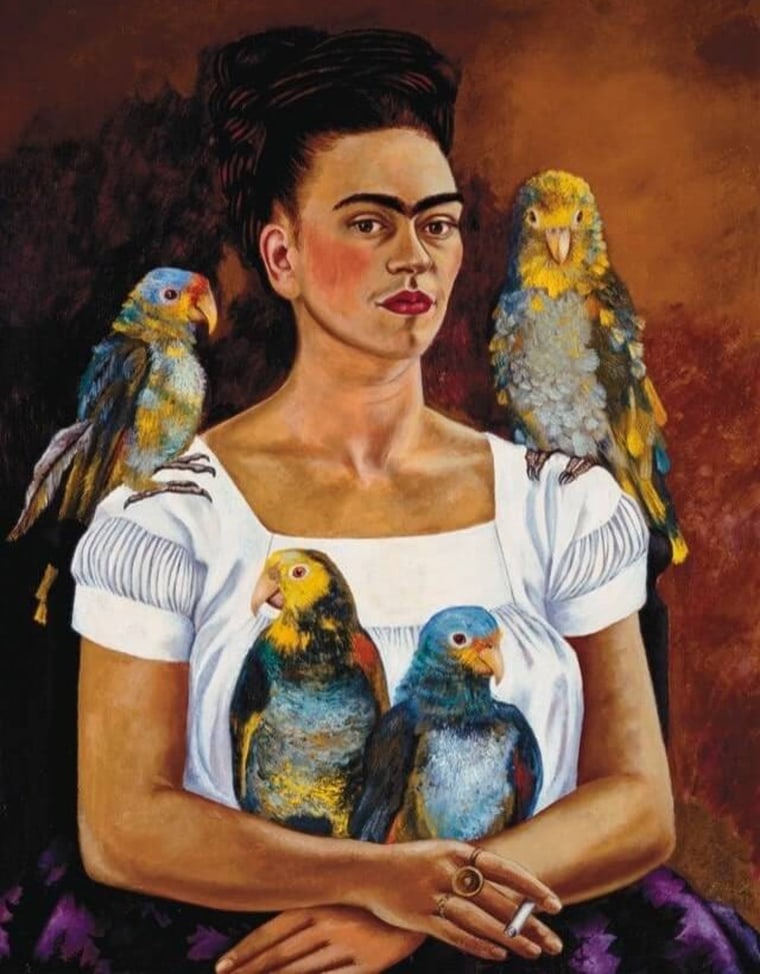
To accomplish this, she and her team got unrestricted access to research materials that have never been shown to the general public before.
It took them two years to parse through everything and create a unique cinematic experience for those who have loved Kahlo for years and others who are just learning about her legacy.
Gutiérrez said the experience of reading Kahlo's writings and getting to know about her feelings firsthand "made me really feel her a lot, in a closer way, in a more intimate way.”
“It just made her into a more normal woman that is facing the normal things that we all face,” she said.
Audiences get to see, hear and feel a multitude of Kahlos — at times rebellious and seductive, fearless and defiant, lonely and vulnerable, insecure and fragile.
As a woman who lived with physical disabilities, explored and challenged gender norms, remained politically active and lived a tumultuous love life, the film provides a satisfying ending that makes us gain a new understanding of Kahlo's last painting: a still life of watermelons with the Spanish words "Viva la Vida" (Live Life).
It brought meaning to "that symbol, that sometimes is a little bit reductive," Gutiérrez said.
"Frida" will be available to stream on Amazon starting Thursday.
Nicole Acevedo is a reporter for NBC News Digital. She reports, writes and produces stories for NBC Latino and NBCNews.com.
- Election 2024
- Entertainment
- Newsletters
- Photography
- Personal Finance
- AP Buyline Personal Finance
- Press Releases
- Israel-Hamas War
- Russia-Ukraine War
- Global elections
- Asia Pacific
- Latin America
- Middle East
- March Madness
- AP Top 25 Poll
- Movie reviews
- Book reviews
- Personal finance
- Financial Markets
- Business Highlights
- Financial wellness
- Artificial Intelligence
- Social Media
In ‘Frida’ documentary, artist Frida Kahlo’s own words are used to tell her story
This image released by Amazon Prime shows artist Frida Kahlo from the documentary “Frida.” (Amazon Prime via AP)
This image released by Amazon Prime shows promotional art for the documentary “Frida.” (Amazon Prime via AP)
FILE - Mexican Artists Diego Rivera and his wife Frida Kahlo appear in New York on May 11, 1933. A new documentary “Frida” tells the story of Kahlo from her diaries and letters. (AP Photo)
- Copy Link copied
Frida Kahlo used her own experiences to inform her art. In that spirit, Kahlo’s personal writings are used to help tell the story of her life in a new documentary, “Frida.”
Filmmaker Carla Gutiérrez blends first person narration with archival footage and interpretive animation of Kahlo’s work in the film, which is now streaming on Prime Video.
Gutiérrez, who was born in Peru and moved to the United States when she was a teenager, remembers first really connecting with Kahlo’s paintings in college.
“I was a new immigrant and there was one specific painting that really introduced me to her voice as an artist of her in between the border of the United States and Mexico,” Gutiérrez said in an interview with The Associated Press earlier this year. “I just saw my experience at the time really reflected in the painting. Then she just kind of became part of my life.”
Gutiérrez was an editor by trade and content with that path in filmmaking. She was working on meaningful projects like “RBG” and “Julia,” which allowed her to be intimately involved creatively. But when a director friend whispered Kahlo’s name to her, she went back and re-read one of those books she’d read in college. Within hours she was making plans to direct.
“I feel like this story really just kind of told me that I needed to step up and direct this one,” she said. “I realized she could tell a lot of her own story and I felt like that hadn’t been made yet. Hopefully it’s a new way of getting into her world and in her mind and her heart and really understanding the art in a more intimate, raw way.”
Kahlo did not do many interviews herself over the years, Gutiérrez said, but she did write very intimate and personal letters. She was surprised by her sense of humor, her sarcasm and her irony as well as and “how explicit she was about her opinions.”
“It’s kind of like messy confidence and messy feminism in a way,” she said.
The filmmaking team had to search several different museums to find those letters that they would compile into a full picture, including the Frida Kahlo Museum in Mexico City, the National Museum of Women in the Arts in Washington D.C. (where her correspondence with her mother was housed) and the Philatelic Museum of Oaxaca, where they found her letters to her doctor about everything from her complex marriage to her miscarriage.
One of the biggest creative decisions was to animate Kahlo’s art throughout, which has proved a bit divisive since the film premiered at the Sundance Film Festival earlier this year. Some love it. Some don’t. But it was part of the vision for the film from the earliest stages. The hope, Gutiérrez said, was to transport audiences from the real world into her internal world.
“I always thought about her heart and her veins just kind of moving from her hands into the canvas,” she said. “We wanted to be very respectful to the paintings but bring in lyrical animation to feel like we were immersing into her actual feelings and heart.”
She is also especially proud that her collaborators are mostly Latinx and bilingual. The composer is Mexican. The animation team is all women from Mexico.
“To inject this cultural understanding of the country into the film is fantastic,” she said.
Screen Rant
Frida review: frida kahlo’s complex life gets a unique personal spotlight in compelling documentary.
Frida explores the life of Mexican artist Frida Kahlo using her own words, painting a compelling picture of her life in this striking documentary.
- Frida explores the life of Mexican artist Frida Kahlo, using both her art and her writings to reflect her complex life.
- Narratives from her diary entries and letters provide insight into how her life influenced her art.
- The documentary combines real-world visuals with Kahlo's paintings to capture the essence of her intertwined life and art.
Artist Frida Kahlo is one of the most recognizable Mexican painters in history. Known for the portraits and self-portraits she painted throughout her life, she utilized surrealism to create art that was both historical and autobiographical. In addition to her paintings, she wrote extensively about her life in diary entries, letters, and essays, crafting a much larger view of who she was as a person. All her work intersects in Frida , a 2024 documentary directed by Carla Gutiérrez about her life told through the words and images she created.
Frida is a documentary film by director Carla Gutierrez released in 2024. Gutierrez takes viewers on a journey through the life of the Mexican painter Frida Kahlo by narrating it from the first person and using various narrative devices such as animations and interviews to help explore her world as she saw it.
- Frida adds complexity to the painter's life by using her own words
- Through moving artwork & narration, Kahlo's life is deeply explored
- Frida has a great visual style that makes for a compelling watch
- Frida captures how Kahlo's life and art informed one another
Frida Is A Stylistic Display Of An Artist's Life
Kahlo's paintings and writings are on full display..
While Frida shares the same name as the 2002 film where Salma Hayek plays the titular artist, the documentary has a clear focus on Kahlo's own words and paintings. Stylistic animations breathe vivid life into her most famous artwork, turning them into living parts of the documentary. These works are presented at various points throughout her life, oftentimes reflecting the intersection between her experiences and her creations. While the decision to animate her paintings is an unusual one that takes some getting used to, their lively presentation resonates with the documentary's purpose.
These animations are accompanied by a narrative woven within her writings, read throughout by actor Fernanda Echevarría del Rivero. Diary entries and letters reveal the extent to which the positive and negative elements of her life influenced her creations. They make up the backbone of the film's narrative, telling the story of her life experiences through an autobiographical perspective. Kahlo's artwork and writings compliment one another, revealing just how influential the complexities of her personal life were with her art.
Frida (2024)
Beyond what she herself created, the documentary bolsters the narrative of Kahlo's life with photos and videos of her spanning nearly five decades. These real-world visuals help highlight the documentary's purpose as an examination of her life through her own eyes. They also provide a contrast between the surrealist, oftentimes fantastical world of her artwork to the grounded nature of reality. By using photos and videos of her, Frida expertly captures the essence of how her life and art intertwined throughout the years.
10 Best Biopics About Iconic Women
Frida reveals the captivating story behind the famous mexican artist, the artist's personal life is a major focus of the documentary..
The Prime Video documentary captures the essence of who Kahlo was as a person, both within herself and to those around her. Frida displays her questioning, rebellious attitude, notably through her interactions with religion and sexuality throughout her life. These make their way into her personal life, and thereby her paintings, offering a close study of her relationship to these topics through her own eyes. The same form of presentation appears as parts of her life are explored, such as a life-altering accident and a tragic loss after her marriage.
The intersection between her real-world experiences and their reflections in her artwork make the documentary as close as the world will come to knowing how she felt through the many stages of her life.
One engrossing, focal section includes her relationship with fellow artist Diego Rivera , whose murals were just as renowned as Kahlo's paintings. These moments showcase how Kahlo fit into the wider world of Mexican art in the early 20th century, as constructed through her often imperfect marriage. They're also contrasted with other, more tender moments in the form of her love letters, their varied prose revealing her innermost desires. While this occasionally leads to some repetitious moments in the documentary, they prove important to understanding Kahlo beyond her artwork.
With a variety of art and writings reflecting her life, Frida takes an honest look at the complex painter through her own eyes in a creative and informative way. The intersection between her real-world experiences and their reflections in her artwork make the documentary as close as the world will come to knowing how she felt through the many stages of her life. While the information on display may be familiar to those who know of Kahlo, her own perspective is a powerful one. Informative for newcomers and the familiar, Frida is a must-watch biography.
Frida is now available to stream on Prime Video.
- Saudi Arabia
- Palestine-Israel
- Arab Showcase
- Australasia
- The Americas
- Environment
- Road to Net Zero
- Art & Design
- Film & TV
- Music & On-stage
- Pop Culture
- Fashion & Beauty
- Home & Garden
- Things to do
- Combat Sports
- Horse Racing
- Beyond the Headlines
- Trending Middle East
- Business Extra
- Culture Bites
- Year of Elections
- Pocketful of Dirhams
- Books of My Life
- Iraq: 20 Years On
Frida review: Amazon's new documentary is must-watch for any Kahlo fan
Director carla gutierrez has produced a stunning and immersive portrait of the famed mexican artist.
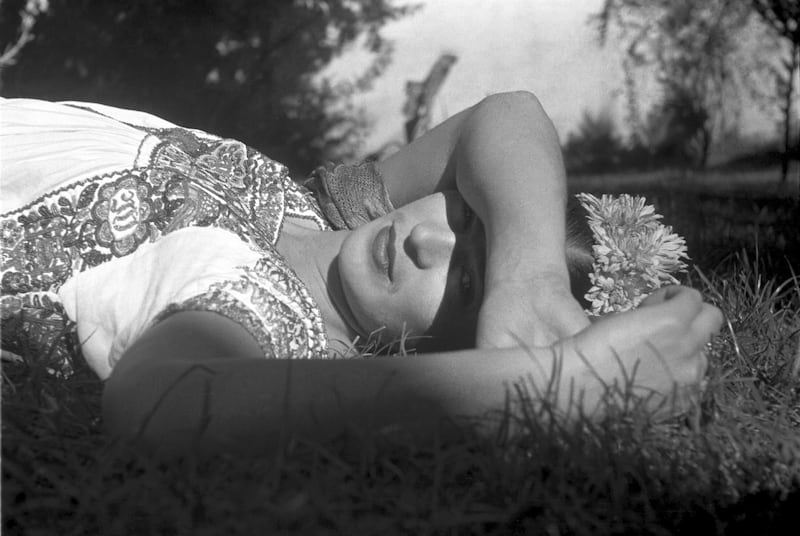
Frida highlights why the famous artist's work will forever be immortal. AP
Frida Kahlo is now recognised as one of the most important and famous pop culture figures of the past 100 years. But while she gained more notoriety towards the end of her short life – she died at the age of 47 in 1954 – the Mexican painter’s work was mostly overlooked while she was alive.
Carla Gutierrez’s stunning and immersive documentary Frida does an incredible job of telling Kahlo ’s remarkable story. Most of the dialogue used is from the artist’s letters, writings, and illustrated diaries and the documentary is told from her point of view, using her words, and from her perspective.
Gutierrez also uses animation to dive into Kahlo’s paintings, drawings, portraits, and self-portraits, which delightfully complement the voice-over of her innermost thoughts and desires. The result is an exploration of her work and life in a manner that most other documentaries could only dream of.
Of course, Gutierrez and her team are lucky that Kahlo left so much intimate and vulnerable material for them to use. But they utilise it in such a mesmeric and authentic manner that Kahlo fans will never have felt so close to the artist. Even people with just a passing knowledge of Kahlo will come away appreciating and understanding her life, her work, and the pain she endured and then depicted in her art.
With a running time of only 87 minutes, Frida indeed whooshes by with a verve and pace that ensures it’s always fascinating. There was so much to Kahlo, though, that Frida might actually have benefited from being longer. Certain aspects of her life – such as her politics, skills, legacy and death – aren’t given the attention viewers will be craving. Though it makes sense the latter two aren’t touched upon as much, considering the documentary is from Kahlo’s perspective.
What Frida does do, though, is give riveting insight into how Kahlo’s creativity and point of view were born. Gutierrez uses a mix of family photos and archival footage of Mexico City to show the influence of her father Guillermo, a photographer and atheist, who was the catalyst for Kahlo’s inquisitive, provocative, playful, honest, and empathetic outlook, all of which bled into her work.
Where Gutierrez’s direction really shines, though, is in the way she depicts the devastating bus accident that Kahlo was in at the age of 18 and the impact it had on her. This pushed Kahlo from being a medical student to becoming an artist. At the same time, her injuries were so severe that she suffered agony for the rest of her life and in her last few years she could barely stand or sit, needing to have her leg amputated.
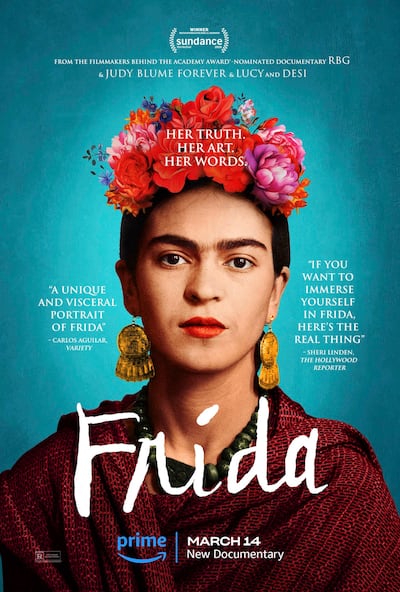
In the sequences where we hear Kahlo, who is magnificently voiced by Fernanda Echeverria del Rivero, talking about her toil and discomfort, Gutierrez simultaneously dives into the intense and vibrant self-portraits she created, giving viewers a deeper comprehension of Kahlo’s pain, as well as a unique viewing experience.
Director: Carla Gutierrez
Starring: Frida Kahlo
Rating: 4/5
It’s not all doom and gloom, though. While her marriage to the womanising Riviera was undeniably topsy-turvy, Kahlo’s honest thoughts on America while they visited there for his work are hilarious to hear. She had a huge disdain for high society, while the longer they stayed in the States, the more she couldn’t understand the entire country’s pursuit of materialism, especially considering that so many people were experiencing the Great Depression at the time.
Plus, the stories of her own affairs, her rebellious spirit in school, and her artistic recognition and growth during the late 1930s and 1940s show that Kahlo had a lust for life that was sadly hampered by her failing health. Frida doesn’t just bring her back to life, it allows her to tell her story in her own words, while highlighting why her work will forever be immortal.
Frida is now streaming on Amazon Prime globally
The Arts Edit
A guide to arts and culture, from a Middle Eastern perspective

TV and Streaming | How ‘Frida’ director Carla Gutierrez…
Share this:.
- Click to share on Facebook (Opens in new window)
- Click to share on Twitter (Opens in new window)
- Click to share on Reddit (Opens in new window)
- Click to print (Opens in new window)
- Food & Drink
- Amusement Parks
- Theater & Arts
Things To Do
Tv and streaming, tv and streaming | how ‘frida’ director carla gutierrez rediscovered material about the iconic mexican artist.

Documentary filmmaker Carla Gutierrez still remembers the moment her obsession with Mexican artist Frida Kahlo began more than two decades ago.
“I hadn’t seen her art until I was a freshman in college,” says Gutierrez, a film editor who makes her directorial debut with the new documentary “Frida.” “Then I found one piece, one painting in a book in the library.
“It was of her standing between the United States and Mexico,” she says. “You can see her full body – we actually use that painting in the film. And I was a pretty new immigrant. I had been in the States for, I think, two to three years.
“I really saw my experience reflected there,” she says. “A little bit of hesitation about my new surroundings and really missing home.
“So I feel like the story for me, it started back then,” says Gutierrez, who also co-edits the film, a role she’s previously done on such documentaries as “RBG” about Supreme Court Justice Ruth Bader Ginsburg, and “Julia,” about chef Julia Child. “When I came back to her story at 47 years old, I was actually the same age [she was when she died] when I started looking into her story. Which was kind of shocking to me.”

“Frida” is a new documentary film from director Carla Gutierrez in which the narration is primarily taken directly from the letters, interviews and diaries of the Mexican artist Frida Kahlo. (Photo courtesy of Fundacion Leo Matiz)

Frida” is a new documentary film from director Carla Gutierrez in which the narration is primarily taken directly from the letters, interviews and diaries of the Mexican artist Frida Kahlo. (Image courtesy of Amazon Prime Video)

Frida” is a new documentary film from director Carla Gutierrez in which the narration is primarily taken directly from the letters, interviews and diaries of the Mexican artist Frida Kahlo. (Photo by Lucienne Bloch, Courtesy Old Stage Studios)

This Feb. 8, 2013 photo shows Frida Kahlo’s 1942 painting “Self Portrait with Cropped Hair” as part of an exhibition at the High Museum in Atlanta. A new documentary titled “Frida” opens on Prime Video on Thursday, March 14, 2024. (AP Photo/David Goldman)

“Frida” is a new documentary film from director Carla Gutierrez in which the narration is primarily taken directly from the letters, interviews and diaries of the Mexican artist Frida Kahlo. (Photo by Lucienne Bloch, Courtesy Old Stage Studios)

A journalist looks at a painting by Mexican artist Frida Kahlo entitled “Self portrait with Braid” during a visit to her exhibition “Oltre il mito” (Beyond the Myth) in Milan on Jan. 31, 2018. A new documentary titled “Frida” opens Thursday, March 14, 2024. (Photo by Miguel Medina/AFP via Getty Images)

Diego Rivera dictating to Frida Kahlo in their hotel quarters in New York City on May 11, 1933. A new documentary titled “Frida” premieres on Prime Video on Thursday, March 14, 2024. (Associated Press file photo)

A visitor looks at “Self-Portrait as Tehuana or Diego on My Mind” by Mexican painter Frida Kahlo at the Frida Kahlo Retrospective at Martin-Gropius-Bau on April 29, 2010 in Berlin, Germany. A new documentary titled “Frida” opens on Prime Video on Thursday, March 14, 2024. (Photo by Sean Gallup/Getty Images)

Mexican muralist Diego Rivera and his artist wife Frida Kahlo at their home in Mexico City in April 1939. (Associated Press file photo)

Frida Kahlo’s painting “Self-portrait on the Borderline Between Mexico and the United States,” seen here in a German art museum, was the first artwork by Kahlo that filmmaker Carla Gutierrez saw as a college student more than 20 years ago. Gutierrez’s new documentary “Frida” arrives on Prime Video on Thursday, March 14, 2024. (AP Photo/Markus Schreiber)

Frida Kahlo, second from right, is seen here on March 31, 1932, with her husband Diego Rivera, second from left, in Philadelphia, where Frances Flynn Payne, left, was selecting dancers for a ballet, and Mrs. William C. Hammer, right, was the artistic director of the Philadelphia Grand Opera Company. (Associated Press file photo)

A painting by Frida Kahlo titled “Self-portrait with Necklace'” is displayed during an exhibition entitled “Frida Kahlo: Making Her Self Up” at the Victoria and Albert Museum in London on June 13, 2018. A new documentary titled “Frida” opens Thursday, March 14, 2024 on Prime Video. (Photo by Daniel Leal/AFP via Getty Images)

A letter written by Mexican painter Frida Kahlo as displayed at the Casa Estudio Diego Rivera y Frida Kahlo museum in Mexico City in July 2015. A new documentary titled “Frida” uses Kahlo’s own words in letters, diaries and interviews as narration. It opens on Prime Video on Thursday, March 14, 2024. (Photo by Ronaldo Schemidt/AFP via Getty Images)

A painting entitled “Self-portrait as a Tehuana” by Frida Kahlo is displayed during an exhibition entitled Frida Kahlo: Making Her Self Up” at the Victoria and Albert Museum in London on June 13, 2018. A new documentary titled “Frida” premieres on Prime Video on March, 14, 2024. (Photo by Daniel Leal/AFP via Getty Images)

Frida Kahlo, painter and wife of Mexican muralist Diego Rivera, poses at her home in Mexico City, April 14, 1939. (Associated Press file photo)

Frida Kahlo’s final “Bust” self-portrait, “Diego y Yo,” is seen here at a museum in Buenos Aires, Argentina in 2022. A new documentary titled “Frida” opens on Prime Video on Thursday, March 14, 2024. (Photo by Juan Mabromata/AFP via Getty Images)

Painter Diego Rivera raises his fist in a communist salute during Mexican Labor’s anti-fascist demonstration in Mexico City on Nov. 23 1936. Next to him at left is his wife artist Frida Kahlo. (Associated Press file photo)

A visitor looks at self-portraits by Mexican painter Frida Kahlo at the Frida Kahlo Retrospective at Martin-Gropius-Bau on April 29, 2010 in Berlin, Germany. A new documentary titled “Frida” opens Thursday, March 14, 2024 on Prime Video. (Photo by Sean Gallup/Getty Images)

“Frida” is a new documentary film from director Carla Gutierrez in which the narration is primarily taken directly from the letters, interviews and diaries of the Mexican artist Frida Kahlo. (Photo by Manuel Alvarez Bravo)

Married Mexican painters Frida Kahlo and Diego Rivera stand together with a pet dog in front of a thatched-roof hut which houses a number of archeological artifacts in Mexico City in the 1940s. (Photo by Hulton Archive/Getty Images)

“Frida” is a new documentary film from director Carla Gutierrez in which the narration is primarily taken directly from the letters, interviews and diaries of the Mexican artist Frida Kahlo. (Photo courtesy of Amazon MGM Studios)
By then, Gutierrez had explored beyond Kahlo’s 1932 oil painting “Self-Portrait on the Borderline Between Mexico and the United States” that had originally inspired her.
“I spent a couple of decades or more, really connecting to some of her paintings,” she says. “Really following her life very closely.
“Then I went back to the material that had I read back then, and I realized that her voice existed in writing from a lot of different sources,” Gutierrez says. “The books that I was reading at that time just kind of showed me that a story about her could be told through her voice, some of it.”
“Frida,” a colorful, creative portrait of the artist told and illustrated in her own words and brush strokes, arrives on Prime Video on Thursday, March 14.
Searching for Frida
Gutierrez says from the start she wanted to avoid the contemporary talking heads that populate many documentaries on historical figures.
“We never wanted to do interviews, or kind of look at her life from that historical perspective in the sense of art historians or artists who had been inspired by her,” she says. “We wanted for the film to feel as present and as much of her as possible.
“So that’s how it started, with this idea that we could offer an intimacy into her life that had maybe not been shown on film,” Gutierrez continues. “Like really, truly focusing on her words and her voice as much as we could.
“And then it surprised us that by leaning into mostly her emotions, and not necessarily a factual list of what happened in her life, she really took over,” she says. “We just started being guided by her writings as much as we could.”
While Kahlo’s fame as both artist and icon didn’t fully blossom until years after her death, the filmmakers were fortunate that she was nonetheless a well-known and well-documented figure throughout her life. Born in 1907 in a village on the edge of Mexico City, her father, a professional photographer, documented her childhood and young adulthood through the lens of his camera.
After her marriage to the Mexican artist Diego Rivera in 1929, she traveled with him extensively in Europe and the United States, where his fame and her striking looks and style made her a favorite of journalists and photographers.
For Gutierrez, the detective work the film required to track down both visuals and words for the film was a delight.
“The research that went into collecting all of her writings was really intense,” she says. “We not only collected all her writings, but we also did a lot of research on contextual material. We tried to gather every interview from people that knew her that we could find. And the research took us into some interesting places.”
Biographer Hayden Herrera, who wrote the seminal 1983 biography on Kahlo was an obvious choice for Gutierrez and her researchers. Her papers had been donated to the Smithsonian, Gutierrez says, but on going there they discovered that none of the material for “Frida: A Biography of Frida Kahlo,” including scores of interviews with people who knew Kahlo, was there.
“So then we very nicely asked if we could visit her house in Cape Cod,” Gutierrez says. “She’s about 85 years old. And we went up to her attic, and we cleaned her attic, and we found these enormous boxes with all the original research that she did on that book.”
Letters Kahlo sent her San Francisco doctor, who became a close friend, were tracked down in the Oaxaca Museum of Art, she says. Letters she wrote to her mother were located in the National Museum of Women in the Arts in Washington D.C.
“There was a couple called the Crommies, who are in San Francisco, who made a film about Frida,” Gutierrez says of the 1966 short documentary “The Life and Death of Frida Kahlo as Told to Karen and David Crommie.” “They did a lot of interviews with people, like with the nurse that took care of Frida in the last years of her life.
“When I went to their house, they brought up a box full of quarter-inch tapes that hadn’t seen the light of day for 50 years,” she says. “We just lifted up every potential rock out there to find as much as we could.”
An intimate voice
Gutierrez says she started the project well aware of the outward facts of Kahlo’s life. Making the film, and focusing on Frida’s own words, most of which she never expected would be read by those outside her intimate circles, allowed Gutierrez to enter the heart and mind of the artist.
“I knew the facts of her life really well because of the books that I had read,” she says. “Really listening to the texture of her personality was special. That was really new and refreshing to get to know her in a new way, through her own words.
“Like, I knew about her feelings on America, and I knew some of her feelings of Paris intellectuals. But to be able to read everything that she had said about them, and the sharp language that she used was really special.”
That unfiltered voice, at different times funny, poignant or salty, adds greatly to the narration of Kahlo’s words delivered in the Spanish or English in which they were written.
“There were two letters, one written in Spanish, and the other one written in English, with a lot of flowery language about Parisian intellectuals,” Gutierrez says. “That the only thing they do is talk and talk and talk among themselves in cafes and parties. I don’t think she ever got tired of insulting them.
“So really, (we found) the intimacy of her voice itself, but also kind of the messiness of her feelings, and the messiness of being able to really read about her fragility and her fears,” she says. “For example, in the scene about her miscarriage, her letters talking about, or questioning, what decision she is going to make.
“Really, the tenderness of a woman just dealing with regular, but really heavy and important things in her life was really special.”
Art and movement
Beyond the choice to use Kahlo’s own words as the main narration of the film, Gutierrez’s second big decision was to animate some of Kahlo’s art, adding motion to paintings and sketches that had been static works of art on museum walls or artbook pages.
“It was a bold decision,” Gutierrez says. “It could be seen as a controversial decision to touch Frida’s art. But it was a decision I made at the very beginning because I knew that we were working in this cinematic universe. And we were thinking from the very beginning, you know, Frida’s paintings kind of carry her mind and carry her heart, so how do we immerse our audience in this kind of cinematic space into that internal world?
“I really wanted for the film to be able to highlight the emotions that we wanted to underline in the art,” she says. “As we’re talking about moments in her life that made art possible. It was essential for the film to make that really strong connection. What had her lived experiences brought to her art?”
Gutierrez, who was born and raised in Peru before immigrating to the United States, felt comfortable working with the culture of Latin America, but she wanted to find as many Mexican collaborators as possible, given Kahlo’s roots there, and ended up with a mostly Mexican, mostly female team of animators on the film.
She says none of the animations used in the film added elements to the artwork Kahlo had created. Instead, elements already in the paintings now move to underscore the words they accompany.
“For example, where you see the painting of her cutting her hair,” Gutierrez says. “You know it’s coming from a place where she actually felt a lot of self-hate for being in the situation. She didn’t love herself that much. There was desperation. There was a lot of hate. There was a lot of anger.
“So I wanted the movement that we created with the painting to really capture that,” she says. “Then you end up with a painting that really carries all of that anxiety and anger and, you know, desperation that she was living in that moment. So that was the decision.”
- Newsroom Guidelines
- Report an Error
More in TV and Streaming

TV and Streaming | ‘Vanderpump Rules’ spinoff brings a dose of reality TV to the San Fernando Valley

TV and Streaming | Don Lemon’s new show on X canceled after Elon Musk interview

California News | Lori Loughlin pokes fun at herself as she leans into cheating on ‘Curb Your Enthusiasm’

National News | Oscar ratings continue to rebound, highest since 2020

IMAGES
VIDEO
COMMENTS
Frida Kahlo (born July 6, 1907, Coyoacán, Mexico—died July 13, 1954, Coyoacán) was a Mexican painter best known for her uncompromising and brilliantly coloured self-portraits that deal with such themes as identity, the human body, and death.Although she denied the connection, she is often identified as a Surrealist.In addition to her work, Kahlo was known for her tumultuous relationship ...
Kahlo and Trotsky reportedly had a brief affair during this time. Kahlo divorced Rivera in 1939. They did not stay divorced for long, remarrying in 1940. ... Frida: A Biography of Frida Kahlo ...
Magdalena Carmen Frida Kahlo y Calderón (Spanish pronunciation: [ˈfɾiða ˈkalo]; 6 July 1907 - 13 July 1954) was a Mexican painter known for her many portraits, self-portraits, and works inspired by the nature and artifacts of Mexico.Inspired by the country's popular culture, she employed a naïve folk art style to explore questions of identity, postcolonialism, gender, class, and race ...
The Life of Frida Kahlo "I paint self-portraits because I am so often alone... because I am the subject I know best." ... Kahlo and the political icon embarked on a short love affair. Trotsky and his wife remained in La Casa Azul until mid-1939. During a visit to Mexico City in 1938, the founder of Surrealism, André Breton, was enchanted with ...
Frida Kahlo biography. Considered one of Mexico's greatest artists, Frida Kahlo was born on July 6, 1907 in Coyocoan, Mexico City, Mexico. She grew up in the family's home where was later referred to as the Blue House or Casa Azul. Her father is a German descendant and photographer. He immigrated to Mexico where he met and married her mother ...
Frida Kahlo began to paint in 1925, while recovering from a near-fatal bus accident that devastated her body and marked the beginning of lifelong physical ordeals. ... Mexican fantasy painter known as much for her turbulent personal life as her fanciful self-portraits. Kahlo learned to paint in 1925 after recovering from a debilitating bus ...
Frida Kahlo, was born in Coyoacán, a suburb of Mexico City, in 1907, the daughter of a German-Jewish photographer and an Indian-Spanish mother. Despite her European background, Kahlo identified all her life with New World, Mexican heritage, dressing in native clothing wherever she travelled. Injured in a bus accident at the age of 15, Kahlo ...
Life experience is a common theme in Kahlo's approximately 200 paintings, sketches and drawings. ... Frida Kahlo painted Moses, ... Born in 1907, dead at 47, Frida Kahlo achieved celebrity even in her brief lifetime that extended far beyond Mexico's borders, although nothing like the cult status that would eventually make her the mother of the ...
Frida Kahlo, The Two Fridas (Las dos Fridas), 1939, oil on canvas, 67-11/16 x 67-11/16" (Museo de Arte Moderno, Mexico City) Sixty, more than a third, of the easel paintings known by Frida Kahlo are self-portraits. This huge number demonstrates the importance of this genre to her artistic oeuvre. The Two Fridas, like Self-Portrait With Cropped ...
Frida Kahlo (Mexican, 1907-1954) is one of Mexico's most celebrated and well-known artists, renowned for her surrealistic paintings and self-portraits. Born in Coyoacán, at the age of six, Kahlo contracted polio, leaving one leg shorter than the other, which she covered with long skirts. Kahlo attended the renowned National Preparatory ...
Frida Kahlo, original name Magdalena Carmen Frida Kahlo y Calderón, was a Mexican painter born in Coyoacán on July 6, 1907. She died on July 13, 1954. As a child, Frida contracted polio and, at the age of 18, she suffered a severe bus accident that nearly took her life. As a result, she had to undergo 32 surgeries over the years.
Updated on July 24, 2019. Frida Kahlo (July 6, 1907-July 13, 1954), one of the few women painters that many can name, was known for her surrealistic paintings, including many emotionally intense self-portraits. Stricken with polio as a child and injured badly in an accident when she was 18, she struggled with pain and disability all her life.
Mexican artist Frida Kahlo lived an extraordinary life which remains much celebrated today. Her work ranks amongst the finest of any Mexican artist and the extreme highs and lows of her life are captured in our extensive biography. This famous artist was born on the 6th of July, 1907 in Coyocoan, Mexico City, Mexico and was one of four sisters.
Magdalena Carmen Frida Kahlo y Calderón de Rivera, better known as Frida Kahlo (July 6, 1907 to July 13, 1954), was a Mexican painter of the indigenous culture of her country in a style combining Realism, Symbolism and Surrealism.She was the wife of Mexican muralist and cubist painter Diego Rivera. Kahlo's life was a tragic one.
10 Facts About Frida Kahlo The Mexican painter and political activist led a troubled life and left a lasting legacy. By Google Arts & Culture. Frida Kahlo, June 15, 1919 ... with Kahlo and Trotsky not only becoming good friends but also having a brief affair. Frida painting "Naturaleza viva" (Living Nature) in bed, with Diego at her side ...
Kahlo, who died July 13, 1954, at the age of 47, reportedly of a pulmonary embolism (though some suspected suicide), has long been recognized as an important artist. In 2001-2002, a major ...
Died: July 13, 1954 Mexico City, Mexico. Famous works: Self-Portrait with Thorn Necklace and Hummingbird, The Two Fridas, Memory, the Heart, Henry Ford Hospital. Style/Period: Surrealism. Biography: Childhood and Early Life. Frida Kahlo grew up in the village of Coyoacan on the outskirts of Mexico City. She spent much of her life living in her ...
Frida Kahlo Early life. Frida Kahlo was a Mexican artist. Her full name was Magdalena Carmen Frida Kahlo y Calderón. She was born in Coyoacán, near Mexico City, in 1907. Frida grew up in a bright blue house called La Casa Azul with her parents and sisters. When she was six years old she became ill with polio and her leg was permanently damaged.
After Kahlo's death, Rivera had La Casa Azul redesigned as a museum dedicated to her life. The Frida Kahlo Museum opened to the public in 1958, a year after Rivera's death. The Diary of Frida Kahlo, covering the years 1944-54, and The Letters of Frida Kahlo were both published in 1995. Although Kahlo had achieved success as an artist in ...
She enlisted the help of Hayden Herrera, who wrote the definitive Frida Kahlo biography in 1983. Gutiérrez' team combed through Herrera's closets and attic, looking through her archives.
Frida Kahlo is among the most famous Mexican artists of the 1900s. She was known especially for her disturbing style and her many unsmiling self-portraits. She often included skulls, daggers, and bleeding hearts in her paintings .
A short biography; A short biography Frida Kahlo's life in brief. Frida Kahlo was born on July 6, 1907 in the house of her parents, known as La Casa Azul (The Blue House), in Coyoacan. Frida always claimed to be born on 1910, the year of the outbreak of the Mexican revolution, so that people could directly associate her with the modern Mexico.
Like many Kahlo projects, Gutiérrez's storyline rests on the broad narrative arc of Kahlo's life. (If you've read Herrera's biography, you're probably not going to learn much.) But the ...
Frida Kahlo was a Mexican artist who became famous for her self portraits that were strongly influenced by Mexican culture.Did you enjoy this video? You can ...
The new documentary film "FRIDA" by filmmaker Carla Gutiérrez uses the late Mexican artistic icon Frida Kahlo's illustrated diary and intimate correspondence to tell her story in her own words ...
Frida Kahlo used her own experiences to inform her art. In that spirit, Kahlo's personal writings are used to help tell the story of her life in a new documentary, "Frida." Filmmaker Carla Gutiérrez blends first person narration with archival footage and interpretive animation of Kahlo's work in the film, which is now streaming on Prime Video.
While Frida shares the same name as the 2002 film where Salma Hayek plays the titular artist, the documentary has a clear focus on Kahlo's own words and paintings. Stylistic animations breathe vivid life into her most famous artwork, turning them into living parts of the documentary. These works are presented at various points throughout her life, oftentimes reflecting the intersection between ...
Frida Kahlo is now recognised as one of the most important and famous pop culture figures of the past 100 years. But while she gained more notoriety towards the end of her short life - she died at the age of 47 in 1954 - the Mexican painter's work was mostly overlooked while she was alive.
"There was a couple called the Crommies, who are in San Francisco, who made a film about Frida," Gutierrez says of the 1966 short documentary "The Life and Death of Frida Kahlo as Told to ...